

A slightly belated Happy New Year to Members and best wishes and happy birding to you all for 2024.
We didn’t see any owls on our trip to Lunt Meadows sadly. But Ellie saw a ghostly Barn Owl there on a previous visit – lucky her!
James has sent in a video taken by a colleague of his, Lauren Hadfield. She found a Short-eared Owl hunting over moorland in the North Pennines, and this shot the video. What a lovely, evocative film. (We can’t upload videos to the website, so it is attached to the notification email).
Finally, I came across a piece of wicker artwork of a Short-eared Owl at Parkgate Old Baths carpark. It commemorates the 50th anniversary of the Wirral Way. Work has finished here on a new seated viewing area with disabled access.
Not blowing my own trumpet (well, not too much!), but I mentioned the Waxwing invasion this winter, and birds have now been seen on Wirral and in Liverpool. They were often quite mobile, but Bill caught up with a small flock in Upton, and Ellie found some in Childwall.
Finally, a reminder that the RSPB Big Garden Birdwatch takes place from Friday 26th – Sunday 28th January. I know many of you take part in the annual survey.
Thank you to Ellie and Hugh for the photos.
Hugh
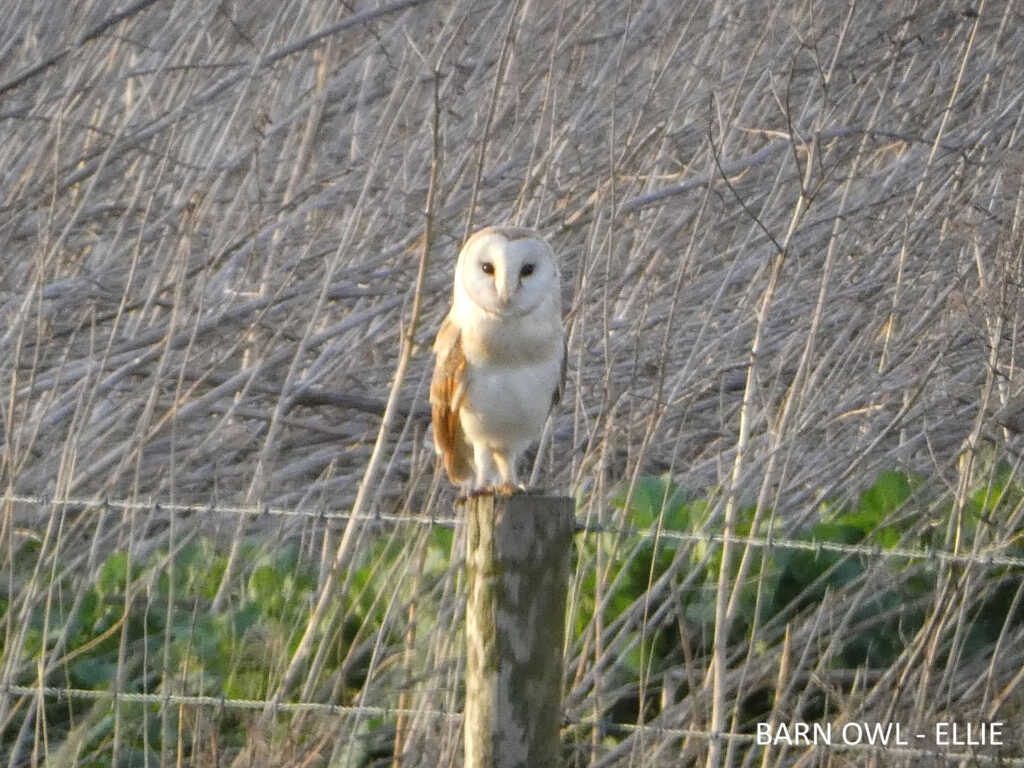
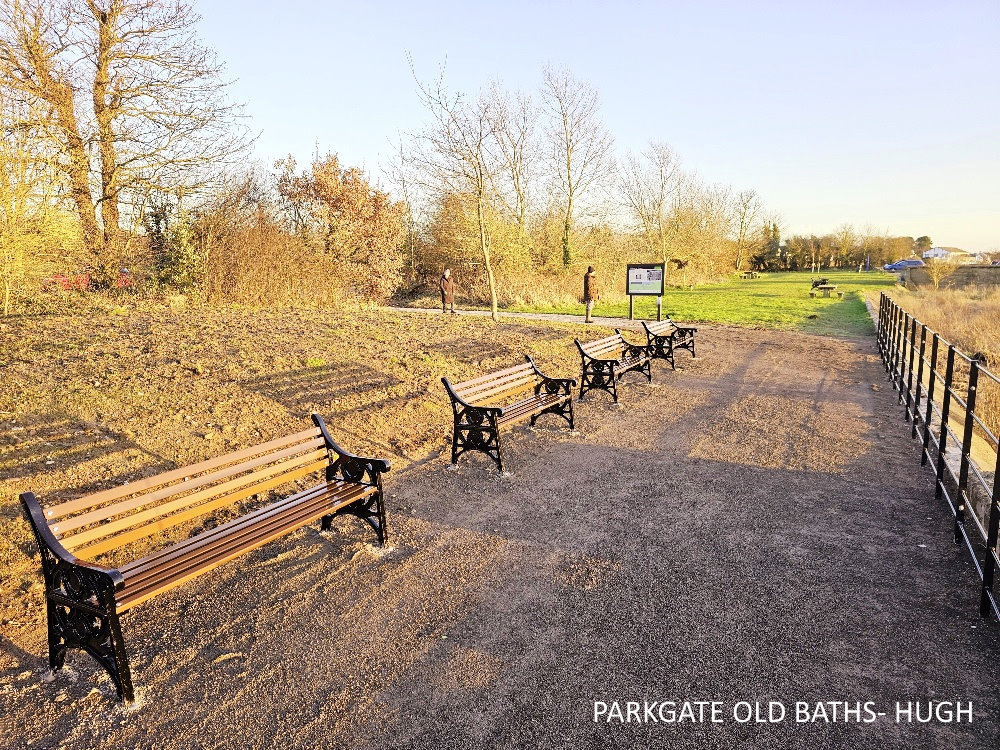
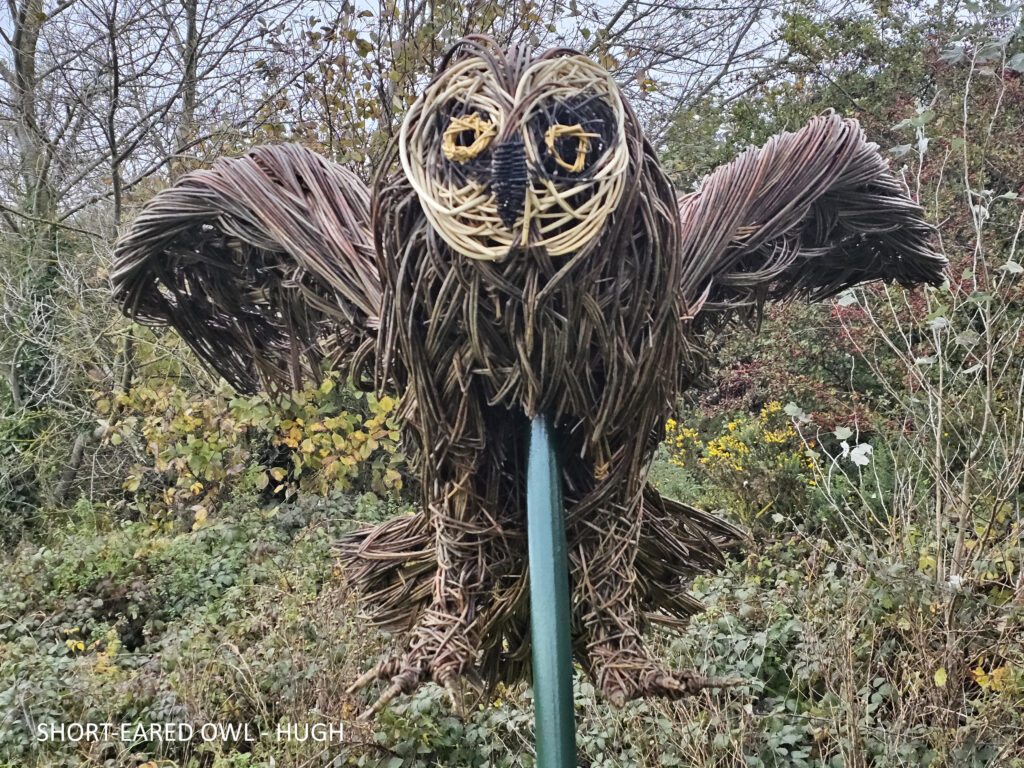
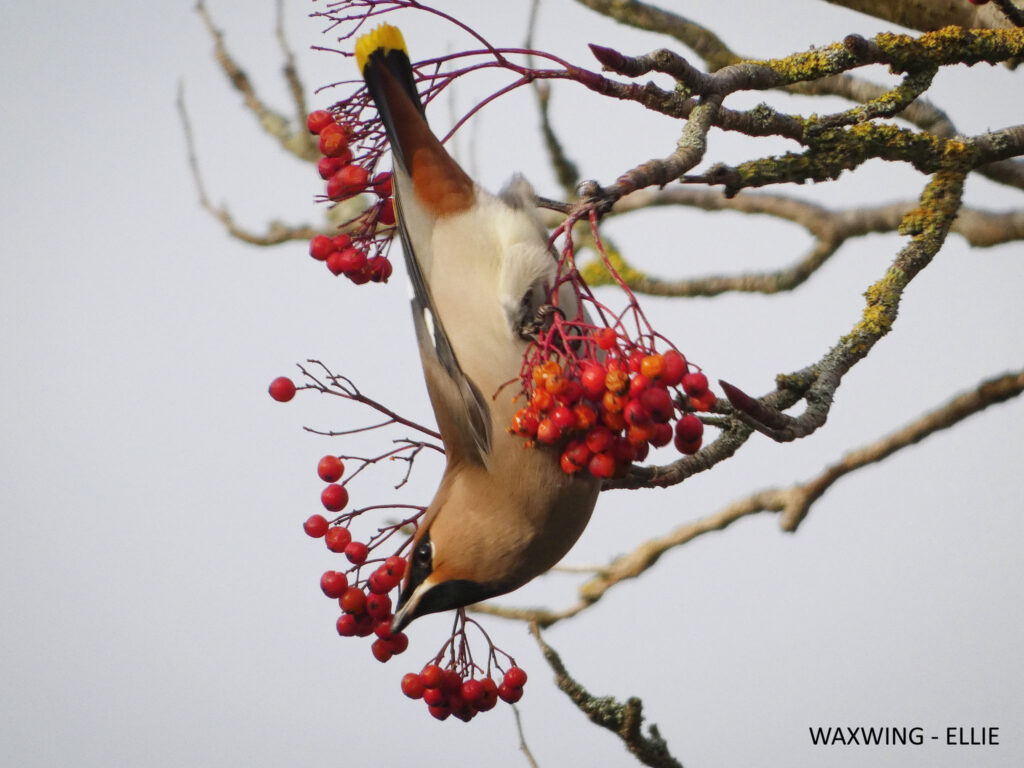
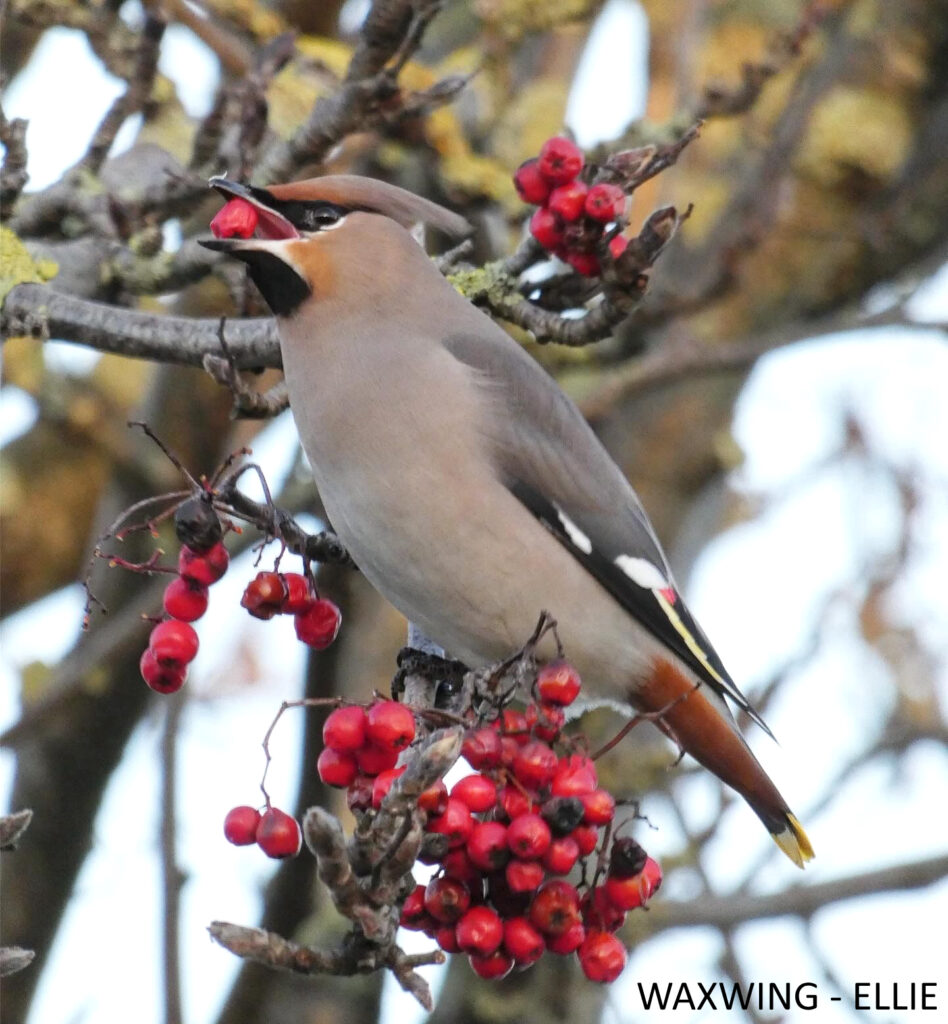
Waxwings have been arriving in the UK in big numbers, in Scotland especially, as well as along the East coast of England. Bill saw this bird on a recent trip to Bempton Cliffs. With luck, a few of these gems could find their way over to our side of the country. It has been several years since a large Waxwing irruption occurred, so one is long overdue.
Reports suggest that this could also be a good year for Short-eared Owls. Look out if you are walking anywhere with views over the Dee Marshes, as this species can be seen hunting during the day. Marsh and Hen Harriers are both present along with Merlin and a single Bittern.
West Kirby Marine Lake often holds Red-breasted Mergansers and Goosanders during winter months, but Bill found a rarer Great Northern Diver there last week.
Ellie had a fantastic encounter at a Red Kite feeding site in LLanddeusant in Wales. The Kites swoop in and take the food without landing, so you must be quick to snap them! As well as the Kites, Buzzards also came in for the scraps.
Members at our last meeting for Keith Offord’s excellent talk will recall he mentioned the long-distance migration of Bar-tailed Godwits. The North American sub-species regularly migrate from Alaska to overwinter in New Zealand. But in 2022, a Godwit smashed the record by flying non-stop from Alaska to southern Australia over 11 days, after taking a wrong turn on its journey to New Zealand! Amazing navigation and stamina.
Thank you to Bill, Ellie and Hugh for the photos.
Hugh
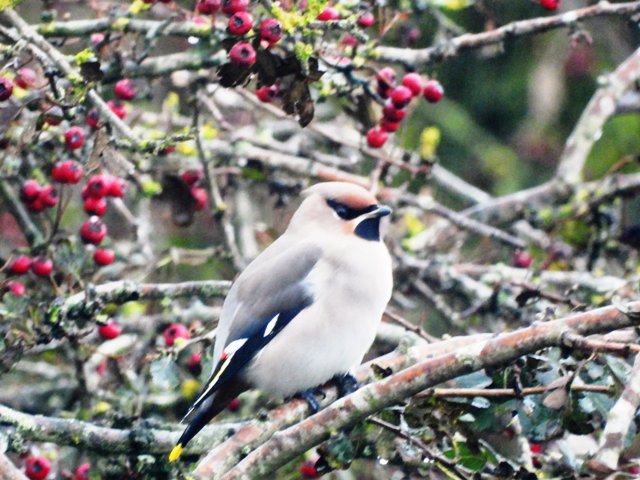
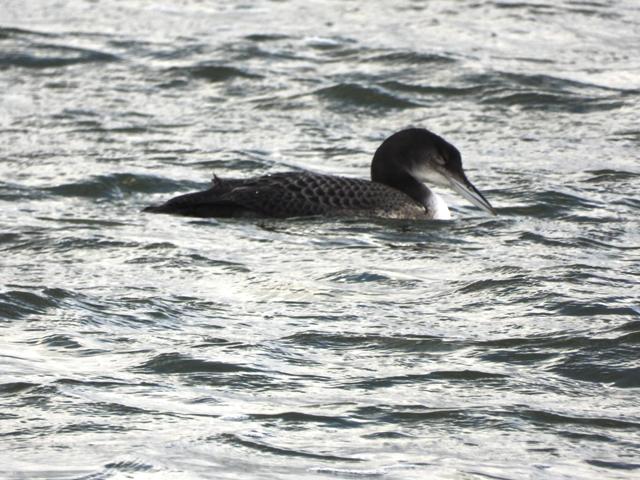
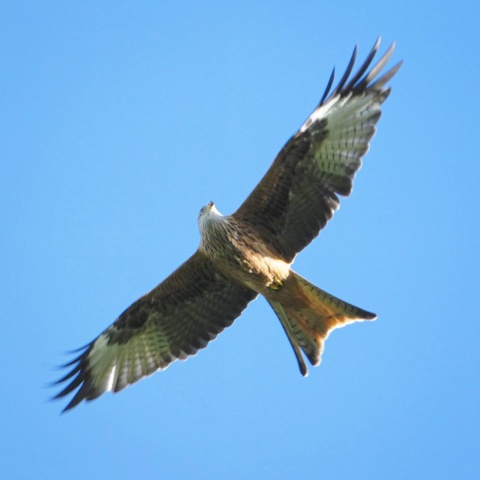
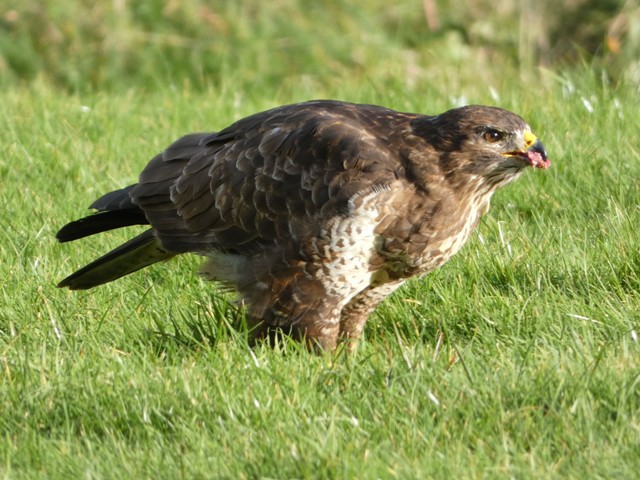
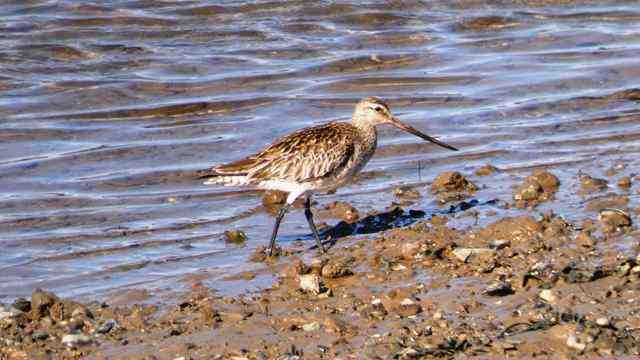
It is difficult to believe that dragonflies and butterflies such as this Red Admiral were enjoying the sunshine just a few days ago.
Looking out of my window at the grey, drizzly weather as I type this, it would seem that summer has finally ended. Temperatures are due to drop significantly by the weekend. We will see how quickly we progress from autumn to winter!
Birds are already starting to return to my garden in larger numbers – they must sense the colder weather coming! Goldfinches are arriving in small flocks – they only came in ones or twos over the last month. There is a regular Wood Pigeon underneath the feeders looking for any spillage.
Pink-feet Geese numbers continue to build, making a great sight in the morning and evening. The first Redwings and Fieldfares winter thrushes have been reported on Wirral, so make sure you scan those berry-laden bushes. I have noticed several, normally shy Jays busily gathering acorns to sustain themselves over winter. Wader numbers are still increasing on the coast, including Black-tailed Godwits that have flown here from their breeding sites in Iceland.
There have been two sub-adult Cormorants for several weeks on Roodee Mere in Royden Park. They must have more success catching fish than the anglers I see there!
We are in the main fungi season, and I found these impressive Shaggy Ink Caps on Heswall Golf Course. Hopefully they won’t be mowed before they’ve spored.
Hugh

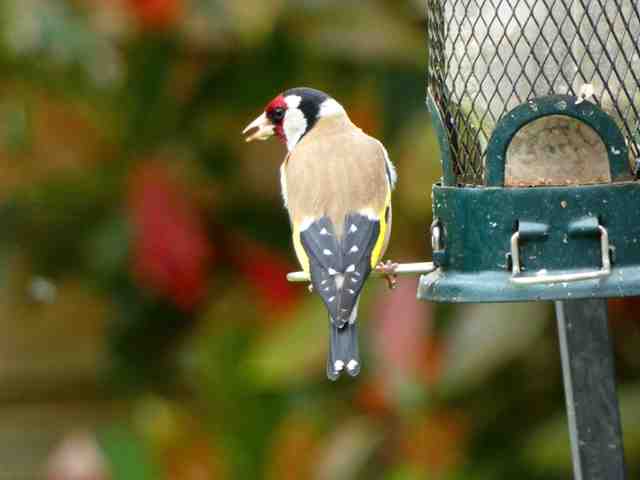




I have been seeking inspiration on what to write about in this latest Hugh’s News. Birding in my garden has gone relatively quiet, as it always does for me at the end of summer. Goldfinches are only occasional visitors now, the usual tits are even less frequent, and the normally regular Robins are scarce. So, this may be a good time to give your feeders a really good clean, in order to reduce the risks of spreading diseases.
Away from the garden, there are plenty of birds to be seen though. Wader numbers are building nicely, with Curlew Sandpiper and Dunlin amongst other species seen at Hoylake over the high tides.
Ellie had some excellent views of Great Egrets at RSPB Burton Mere Wetlands. For once they were roosting in the trees rather than stalking the marshes. She also captured a lovely Kestrel hovering above her.
You may be aware that Wirral Country Park is celebrating its 50th birthday this year. It was the first designated country park in Britain when it opened in 1973 and provides excellent, varied habitat with hedgerows, fields and views of the Dee marshes. We are lucky to have this on our doorstep. You will be able to explore a part of it on the Club’s field meeting there in February 2024! Details to follow nearer the time.
Of course, that’s what I should write about! We have an excellent, new Programme starting in September. If you haven’t (re-)joined the Club yet, please do so as soon as possible to obtain your printed Membership programme with all the details.
Hopefully we will see you soon at one of the Indoor Talks or outdoor Field Meetings.
Thank you to Ellie and Hugh for the photos.
Hugh






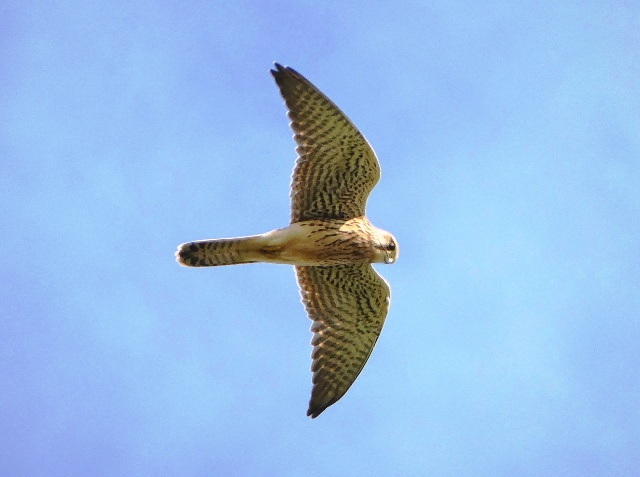
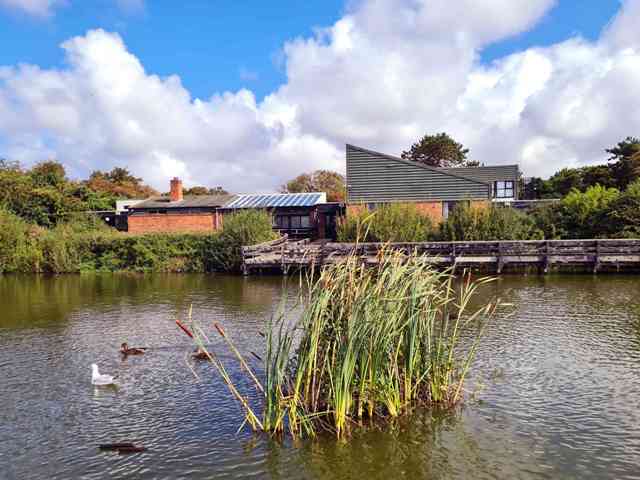
Signs of a fruitful breeding season are all around us now. I suspect that the fine summer we have had over the last couple of months will have helped many parents raise their broods successfully.
At their regular Arrowe Park lake, I saw several female and juvenile Mandarin Duck, but interestingly no males were visible! I wonder where they were hiding? It seems early to be moulting into their eclipse plumage, but this may be the explanation.
Goldfinch are devouring the sunflower hearts at an astonishing rate on my garden feeder, with the occasional Greenfinch coming in as well. The adults are now bringing their fledged young to feed too. Blackbirds, Woodpigeons and Dunnocks are all finishing off the spillage on the grass.
Barry also had a family of Blackbirds eating an apple in his garden, and he is lucky to have regular Great-spotted Woodpeckers. At Burton Mere Wetlands, Barry captured a beautiful image of a Great (White) Egret from the Reedbed Screen.
The picture Barry sent in didn’t do justice to the bird unfortunately, when he found a Wren in his conservatory (so I haven’t included it). After leading him a merry dance, Barry eventually coaxed the bird out!
I am a little late with the warning, but please be aware that Avian Flu is sadly affecting many wild birds. Black-headed Gulls seem to be particularly vulnerable, but other sea and shore birds are being found locally too. Please do not touch any dead or sick birds that you might come across. You should report dead birds to the DEFRA Helpline on 03459 33 55 77.
Thank you to Barry and Hugh for the photos in this article.
Hugh






Bill found a nice Grey Wagtail at Arrowe Park. We can tell it is a male by the all-yellow belly. He also saw an Avocet busy feeding in the water at Burton Mere Wetlands.
At the end of April, Bill travelled to the Great Orme, a well-known hotspot for migrant birds in Spring and Autumn. He saw this cracking Dotterel, possibly on its way to the Scottish Highlands. The breast is partially obscured, but I think the bright rufous feathers indicate that this is a female. The Dotterel is one of exceptions where it is the male that incubates the eggs and sports duller plumage. He also had a female Wheatear.
Martin Donaldson sent in a photo of the Pied Flycatcher we saw at Glyndyfrdwy. We’d just posted the trip report when it arrived, but it is such a cracking image, we had to share it.
We didn’t find a Wood Warbler on the trip, but interestingly one was caught and ringed on Hilbre the following day. Steve Williams from the Bird Observatory wondered if the warblers were late arriving in the UK this spring.
Birds are still busy on my feeders. Goldfinch, Robin and pleasingly Greenfinch, are getting through the sunflower hearts at a huge rate, while the House Sparrows prefer the fat balls.
Blackbirds, Dunnocks and Wood Pigeons hoover up the spillage with glee. These are all adult birds, getting a quick energy boost before going to find food for their broods – except for one young Robin. But it won’t be long before they bring their fledged youngsters to the feast.
Hugh






It is 4 weeks since the last Hugh’s News, and as predicted the summer migrants have now started arriving in earnest. Wheatears, Swallows, Sand Martins and House Martins have all been spotted locally, especially along the North Wirral coast.
A single Reed Warbler was heard at Parkgate, and a pair of Little Ring Plover were seen there too. The numbers of our summer visitors will continue to build over the next few weeks, and more species will start to return too.
Nationally there has been a small influx of wandering Alpine Swifts into the UK, and at least one has been seen around Wirral on a few occasions this week. “Our” Common Swifts have yet to arrive back, so keep a look out for an over-sized, black and white Swift – it may still be around!
I noticed that the local farmer has been busy planting potatoes around Thornton Hough, attracting hundreds of Black-headed Gulls to feast on the exposed invertebrates behind the plough.
We have attached more photos of the birds we saw at Pennington Flash, courtesy of Ellie, Colin, Bill and me. Bullfinch, Reed Bunting, nesting Great-crested Grebes, Wren and Stock Dove are featured.
If you haven’t been watching Richard Attenborough’s Wild Isles series (why not?!), you might want to make a special effort on Sunday 2nd April on BBC1 at 7pm. The programme will feature wading birds and Peregrines of the Dee Estuary and our very own Ranger, Matt Thomas!
Hugh
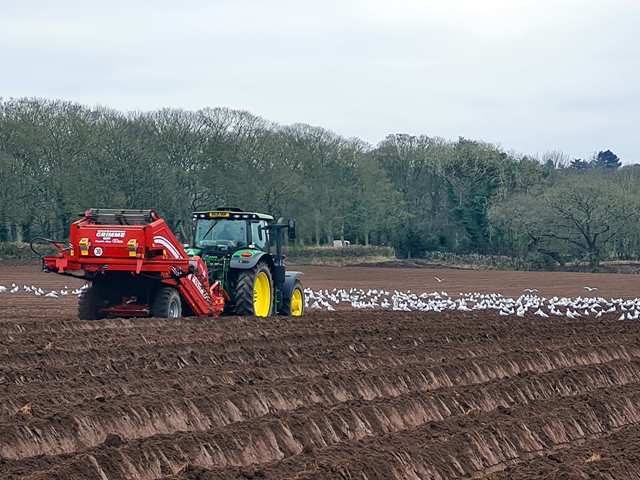
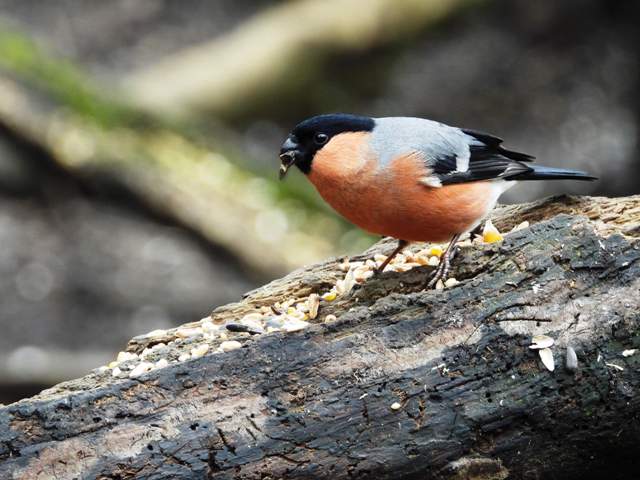

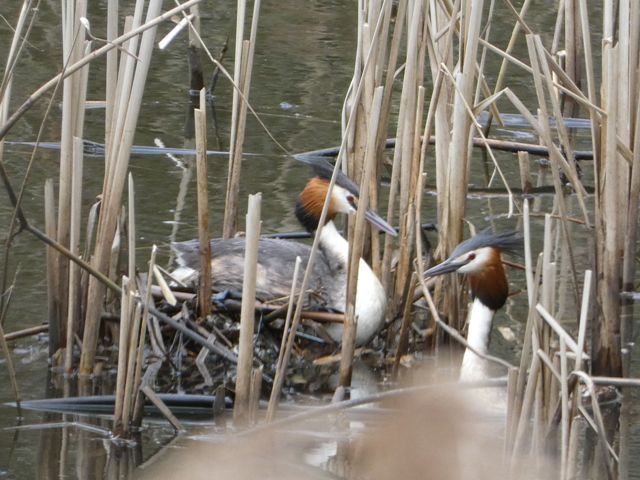
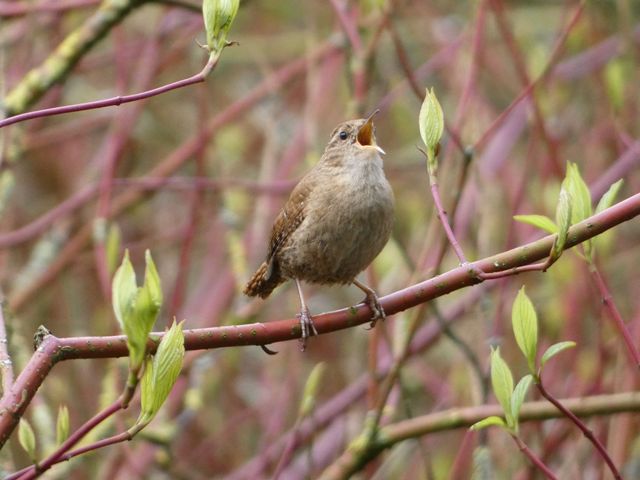
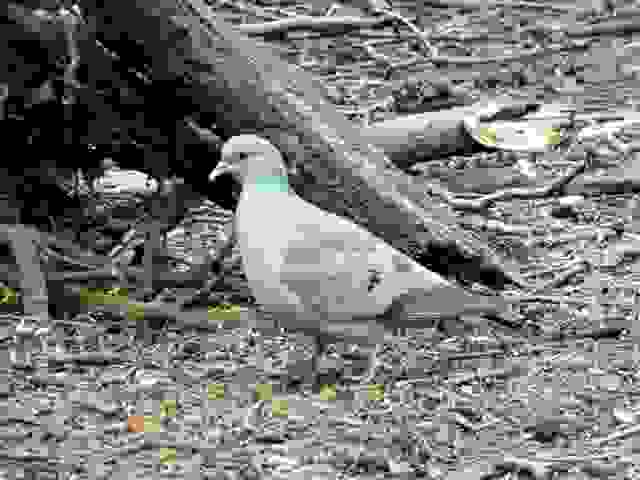
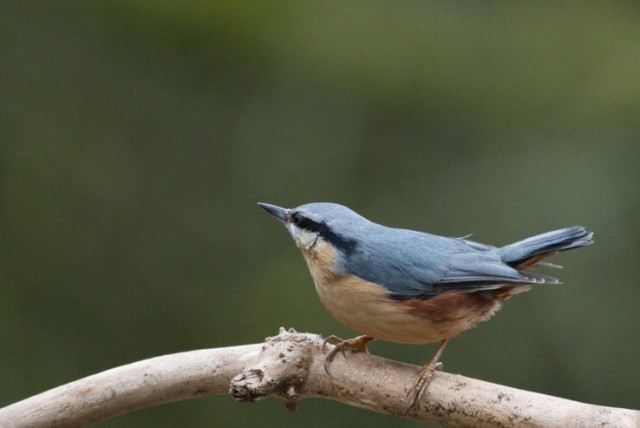
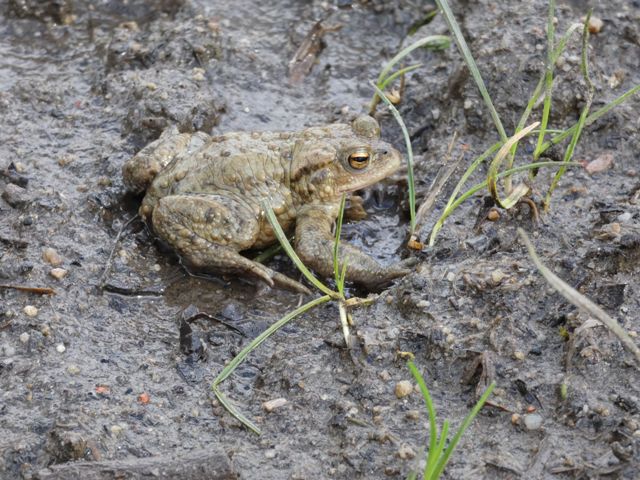
There was sad news from West Kirby of the death of the Red-tailed Hawk that had become something of a local celebrity. Really an American species, this individual escaped from captivity and had lived around the town since 2013. It was admired by many people who saw it perched in trees and on roofs – it wasn’t liked so much by the local feral pigeon population!
Ex-member Jim Anderson sent in a photo of a flock of Linnets on the green beach at Hoylake. Hopefully you can make out the grey heads and pale wing-bars on the birds. The vegetation and embryonic dunes have been attracting numerous birds to feed on seed heads over the winter. A Raven has also been a regular visitor.
As I write, the temperatures are still a little higher than normal for this time of year. Especially if you can shelter from the wind, the days have been mostly pleasant. Consequently, the first signs of spring have been increasingly evident. Spring bulbs are in flower – snowdrops, daffodils and crocuses are abundant.
On our Moore trip last weekend we saw some pussy willow and lots of catkins. And a pair of Great-crested Grebes were performing their courtship dance. Thanks to Ellie and Colin for the stunning grebe photos.
Blackbirds, Song Thrushes and Robins have started singing in earnest.
The first Avocets are back at Burton Mere Wetlands. These hardy and feisty birds are always one of our first summer visitors to return.
By the next issue, migrants will hopefully be arriving in earnest, something to really look forward to.
Hugh
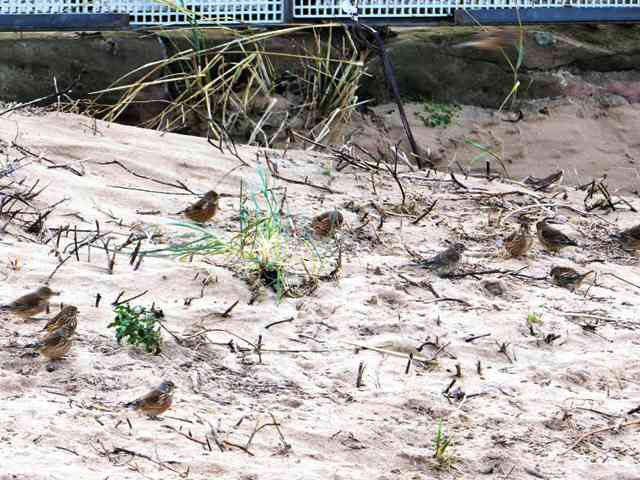
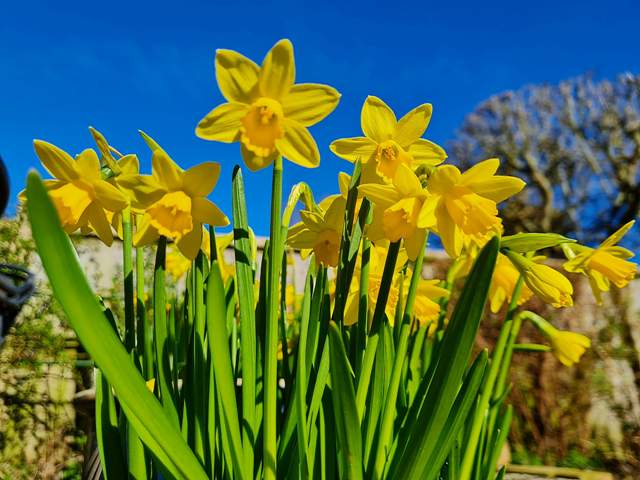

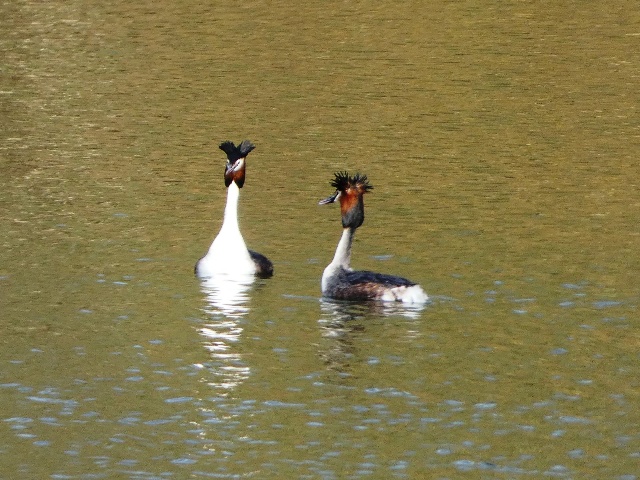
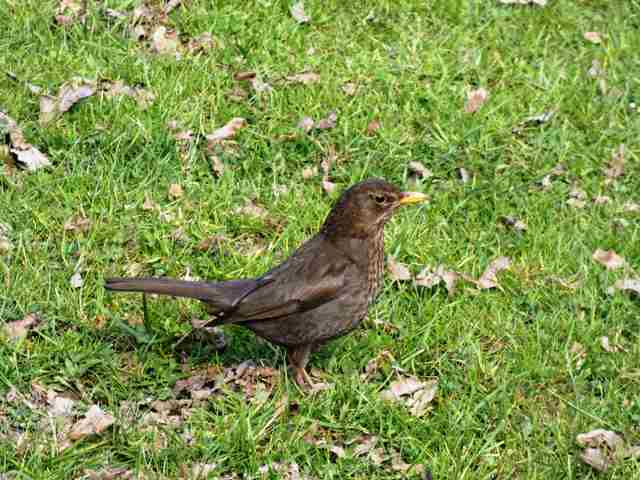


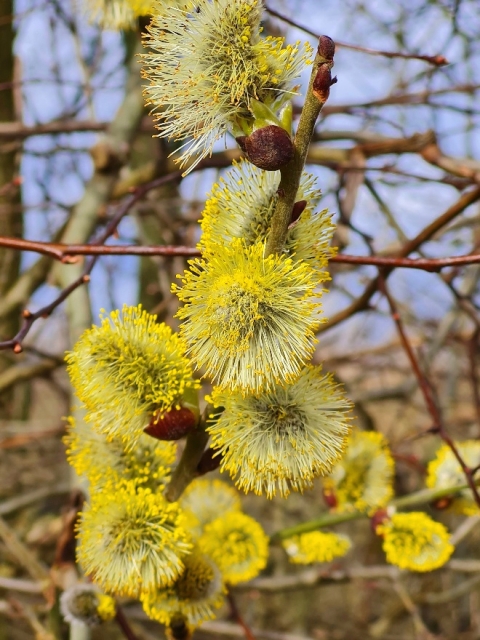
We feature a few of my photos this issue!
First is a Grey Heron stalking in the paddock behind Parkgate Old Baths car park. I suspect it was searching for frogs or similar prey in the wet field.
Great Egrets are now a regular feature locally, and this individual graced Reception Pool at RSPB BMW, allowing great views as it fished in the shallows.
Around my house, Jackdaws are flying acrobatically in large flocks, displaying and calling noisily ahead of the breeding season. This single bird came down to a grassy area at the top of my road.
Last week I noticed a Sparrowhawk fly from the front of my house, over the garage and alight on the fence. It was another wet, gloomy day, but I managed a photo of this small but beautifully marked male bird. It only stayed for a few minutes, then left empty-handed; or should I say empty-taloned!
Parkgate High Tide Watches are back for the first time since early 2020. Tens of thousands of wintering wildfowl and waders are pushed in close by the rising tides, small mammals flee the grasses and birds of prey take advantage.
Dates/Times are:
24th January at 11am, High Tide 12:54pm
21st February at 10:30am, High Tide 11:53am
22nd February at 11am, High Tide 12:36pm
23rd February at 11:30am, High Tide 13:17pm
22nd March at 10am, High Tide 11:31am
23rd March at 10:30am, High Tide 12:12pm
Meet at Parkgate Old Baths Car Park. An RSPB team will help with spotting birds. No need to book, but please be aware the car park can get busy, and it is best to arrive at least an hour before high tide to avoid missing any of the action.
If you are not aware already, the annual RSPB Big Garden Birdwatch takes place from 27th – 29th January. Just spend an hour watching and counting the birds in your garden, then submit the results. It’s fun and easy! But this event provides invaluable data for monitoring bird populations.
More details at: https://www.rspb.org.uk/get-involved/activities/birdwatch/
Hugh




The snow soon turned to ice around my house, making walking very tricky. On the plus side, the freezing temperatures soon brought the birds back to my garden in good numbers. Goldfinches, Tits and Robins devoured the sunflower hearts, so much so that I had to buy more stock today. Starlings favour the fat balls, and there are more of the squabbling birds than I have had for a long time. Blackbirds pick up the fallen scraps together with cut apples for dessert. Sadly no Redwings or Fieldfares as yet, but they are around feeding on berries.
While the weather is milder now, the garden is still busy which helps brighten the grey days.
I have attached another couple of photos from John and Anne Carus from the last field trip to “The Harp” and Denhall Quay. One shows the snow we endured! The other is the Song Thrush we saw at Net’s Cafe.
Peter Ham sent in this wonderful image of the Glossy Ibis at BMW in November. It captures the lovely sheen that the bird can show.
And finally, Bill snapped a sunning Little Owl at Burton Point – this is one of the best photos of this particular bird I have seen.
This should be the last message of the year, so on behalf of the Committee, I thank you for supporting the Club and the meetings.
Wishing you and your families a Merry Christmas and looking forward to seeing you again in the New Year.
Regards,
Hugh






The number of Starlings roosting in the reed bed at Burton Mere Wetlands is building nicely, and the murmurations are really impressive just now. Bill captured the attached scene this last week.
To experience it for yourselves, get down to the Visitors Centre for the last hour before closing, around 3:30pm.
Member Martin Donaldson took a great photo of the Long-billed Dowitcher that was at BMW last month. This is a North American wader that occasionally turns up in Britain. Superficially it looks similar to a Snipe, with a plumpish body and long, straight bill; but it lacks the bold stripes of a Snipe.
Ellie captured a nice Dunnock. Easily overlooked scurrying in the undergrowth, they have subtle but beautiful markings when seen well.
We were sent another photo of the escaped Red-tailed Hawk, seen on a roof on Banks Road in West Kirby by Nick Baty. You can see it is still sporting a jessie ring on its right leg. It seems to be flourishing still!
I hope to be able to give a talk to the Club based on my recent trip to Namibia and Botswana. It won’t get into the programme for a year or two though, so here are a couple of teasers.
While it is unusually mild as I write this, winter will surely arrive properly soon. So, if you’ve not done it recently, clean your feeders and fill them up ready for the birds when the temperatures fall. And keep any water baths clean and full, especially if the conditions freeze.
Hugh


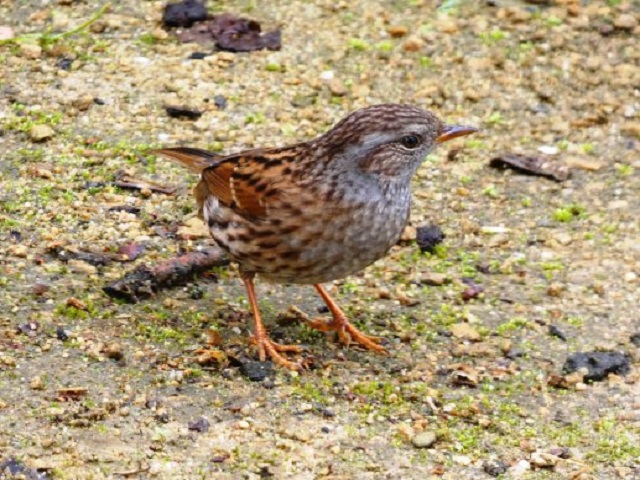

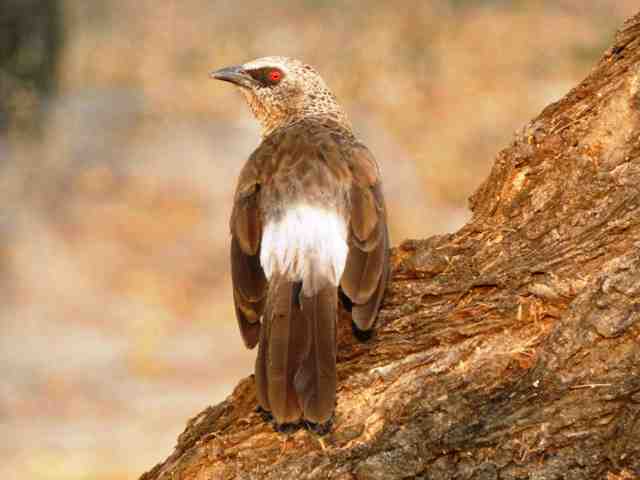

In this edition, I we are happy to share some more members’ photos from recent field meetings. There is not always space to include them all in the reports, but they deserve to be shown. I hope you like them.
Ellie was also lucky to see the Water Rail out in the open at Marbury; and she found one of her local Peregrines enjoying a snack. We’ve also included her Curlew image from our Leasowe meeting.
I’ve also included another of Peter’s Goldcrest photos from Leasowe; and a juvenile Pied Wagtail in one of the horse paddocks.
Bill was fortunate to see both Snipe and a diminutive Little Stint together at Burton Mere Wetlands. To give you an idea of scale, the Stint is sparrow sized!
Also at Marbury Country Park, Maks photographed a Buzzard, which was circling overhead.
One point of potential interest to mention. There are reports of large numbers of Waxwings in Finland currently, so it is possible that we could enjoy another major influx into the UK this winter. They usually arrive in big numbers every 5 – 7 years and such an event is due! So let’s hope we have some of these charismatic birds in our region. I will aim to let you know if this happens.
Hugh







Hopefully you have seen our new Programme already, and are looking forward to another interesting and varied set of meetings over the coming year; as well as the regular Trip Reports and Hugh’s News. We trust you enjoy all the Club’s activities.
New member John Carus and his wife had a wonderful encounter in their garden when a Sparrowhawk landed in the bird bath in their garden in Meols. It stayed for 20 minutes. Apparently a Wood Pigeon was close by for much of the time but the hawk wasn’t interested – maybe the pigeon was too big for it. What a brilliant experience. Sparrowhawks know their territory well and will visit the same gardens on a loop, especially if they know there are feeders present. So John may well get more visits.
Bill made a trip to Whixall Moss where he saw this adult female Red-backed Shrike. No longer a (regular) British breeding bird, a few turn up as drift migrants, mostly on the East coast. So it was great to have one over our side of the country! Sadly though, it won’t stay through until our scheduled visit to Whixall next July.
Ellie has shared the images of a posing Sedge Warbler and a charming, juvenile Little Ringed Plover. Both photos were taken at Lunt Meadows where the two species breed (amongst many others). We will definitely have to put this reserve into our next Programme, it a lovely site.
Moving away from birds temporarily, Ellie also managed to snap a Red Darter dragonfly on a reed. And following on from my photo of a Speckled Wood in last month’s issue, John Gill has sent in his photo of one that he saw on the Wirral Way, typically posing in the dappled sun.
Still on the same theme, my eye was drawn to the bright colour of this Red Underwing moth that landed on a post beside me. As the name implies, the red is often hidden when the moth is at rest so I was lucky to get this view. You can also see how its general plumage blends in brilliantly with the wood.
Hugh







Just to explain for the benefit of new Members, Hugh’s News is aimed at sharing information on birds especially and nature in general in our area. It is issued on an ad hoc basis, but usually monthly. Photo contributions are always welcome, they don’t have to be professional standard! And you can send in articles or ideas too, to Bill or to me. Don’t be shy!
Although we do not meet in August over the school holidays, I hope you are enjoying the glorious weather and still getting out regularly.
I saw this Black-headed Gull in Chester and took a photo from an unusual angle. I quite like the composition. Note the brown, not black head! It will soon be moulting these feathers and adopting its winter plumage with a dark spot behind the eye.
Ellie sent in a couple of photos a little while ago. First, she shot a male Blackcap, notoriously shy birds that typically sing from the depths of a bush. So, she did well to capture it. Like most warblers, he will fly south for the winter.
She also caught this magnificent Buzzard in flight, soaring on a thermal overhead. Thinking about it, I have not seen many Buzzards over the last 2 or 3 weeks. I am not sure why they become shy now – it may be because they are moulting their flight feathers. Don’t worry, they will soon be back on view!
Barry has had great views of Hobby at Burton Mere Wetlands. With young birds also now on the wing, it is a good time to look for these dashing falcons at BMW, Denhall and Parkgate, as they hunt on the wing. Sorry, they were too fast to snap!
I have noticed lots of butterflies in the sunshine, including this Speckled Wood on a path near Heswall Fields.
Many trees are dropping leaves already, unseasonably early. I assume this is caused by drought stress rather than the normal autumnal phenomenon. Beeches at Thornton Hough were even shedding green leaves, although the nuts appeared to be still developing. Beech mast is an important winter food for several bird species, so hopefully it won’t fail badly.
See you again soon.
Hugh





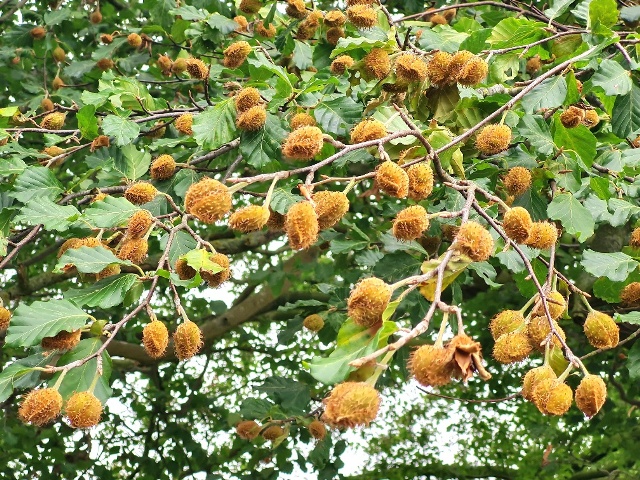
On a visit to South Wales in early June, Ellie photographed two of our classic summer visitors.
Firstly, a Spotted Flycatcher. At first glance these birds may look a little boring but, if seen well, they show subtle but beautiful streaky marking (not spotted!). The bird was performing typical feeding flights catching insects on the wing before returning to its perch.
Secondly, she found a splendid Cuckoo, a bird more often just heard than seen.
Sadly, both these species are in decline in the UK, so it is great that Ellie saw them both so well.
Barry has had Great-Spotted Woodpeckers on the feeders in his garden, including this juvenile bird sporting a full red cap. Males only have red on the nape at the back of the head, while females have all black caps. He has also seen a Jay, one of our colourful birds.
Yesterday, Bill and I had a table at the invite of West Kirby Primary School Summer Fair, to showcase our Club and encourage children and parents to enjoy birds and nature. The kids liked the Word Search sheets we gave out – but I think the Slime Making table next to us proved a little more popular!
While walking the dog on Hoylake Beach, I came across a guided walk led by a couple of local naturalists – Josh Styles and Jane Turner. They came across as extremely knowledgeable, one on the plants that are emerging on the proto-dunes, the other on the local birds and the developing ecosystem. Wherever you may stand on the debate for the future of the beach, you should be able to appreciate their depth of knowledge and enthusiasm for nature. Wirral Borough Council is inviting opinions from the public before a final decision on the future management of the beach is made.
Hugh




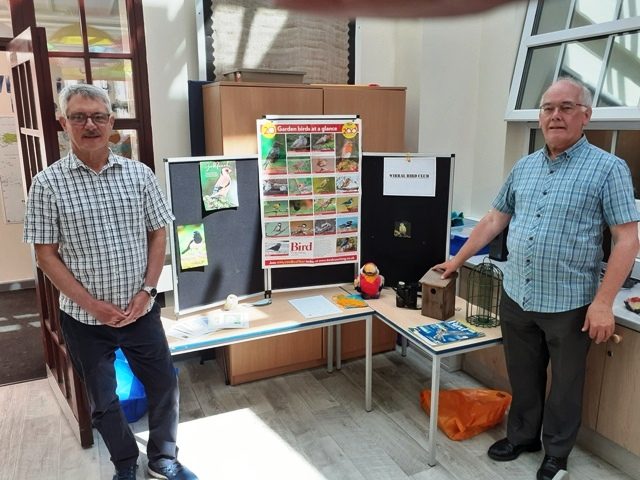

Ellie took a walk over to Hilbre over the low tide. Amongst other birds, she saw several colourful Linnets, and a Little Egret in one of the channels.
Bill caught this Sedge Warbler nicely in its habitat of reed and scrub. He also snapped an Avocet. Both of these were at Burton Mere Wetlands. On a visit to Somerset, Bill called in to the Great Bustard Reintroduction project on Salisbury Plain and saw these 2 impressive female birds.
The impromptu evening walk around Arrowe Park was well attended. The evening was dry although the temperature cooled rapidly as the sun set. We didn’t see anything especially unusual, but a Nuthatch was seen by the stone bridge. Male and female Mandarin were swimming on the lake. And towards the end of the walk, a pair of Treecreepers led us a dance around the trunks. They must have been a pair, busy finding food for their brood.
Just a short mention of the Canal Boat trip. While not an official Club activity, it is only offered to Club members. After an enforced 2 year gap, it was great to run another day out and those onboard enjoyed a wonderful time. The highlight was undoubtedly a Kingfisher that accompanied us for ages, always keeping just ahead of the boat. Hopefully another trip will be organised next year.
Hugh






Bob Beale was fortunate to see a pair of Mandarin from his bedroom window! They were almost certainly looking for a suitable tree hole to build their nest in. They will also use next boxes of the right design. So keep a look out for youngsters in a few weeks, Bob. By coincidence, we were to see several of these duck on the River Wharfe on our coach trip to Bolton Abbey.
Peregrine Falcons have adapted to living in cities over the last several years, including nesting in Birkenhead and Liverpool recently. They nest on high buildings as cliff substitutes and feed primarily on feral pigeons. Ellie is lucky to have had them on her local church for at least 4 years. She learned that the female was apparently poisoned two years ago, but she rematched and has bred again successfully!
It has been a good Spring migration period at Leasowe this year. Bill was fortunate to see this Osprey perched on a pylon on the beach there. It had previously caught and eaten a fish on the beach, to fuel up before resuming its flight north to its breeding site. Ospreys are generally monogamous and the pair return to the same nest every year after wintering on the West Africa coast.
Another passage bird seen by Bill was a smart male Ring Ouzel, this one at Leasowe Langfields. These are the mountain cousins of the Blackbird, but Wirral always seems to attract them each Spring before they move on.
Bill also found a Ruddy Shelduck at Burton Mere Wetlands. This is a female bird as it does not appear to have a black neck-collar of the male. There is usually great debate whether birds seen in the UK are truly wild or are escapes. In the wild their main range is south-eastern Europe and central Asia. They are commonly kept in wildfowl collections though, but influxes have occurred in the UK in the past. Whatever its origin, I hope you agree that it is a colourful bird.
Hugh Stewart





I am sure that virtually everyone is aware of the devastating fire at Neston Reedbed. The following link takes you to a heart-felt account of the fire and implications. We can only hope that the habitat will regenerate in a year or two, and once again Marsh Harriers and the other iconic species will breed again.
https://community.rspb.org.uk/placestovisit/deeestuary/b/deeestuary-blog/posts/neston-reedbed-fire
Bill Wonderley captured this wonderful photo of a male Garganey on Reception Pool at RSPB Burton Mere Wetlands. There was a pair there for several days, with at least 4 other birds seen elsewhere on the reserve. Hopefully some at least will stay and breed. Garganeys are our only duck species that are summer visitors. They are scarce and secretive breeders. They winter in West and Central Africa.
He also captured a male Pochard on a visit to WWT Martin Mere. These are not common in our area, but they can be seen occasionally on larger lakes in winter. Look at those gorgeous red eyes!
An intriguing contact via the Club website informed us of two Ruby-crowned Kinglets apparently seen in Heswall Dales.
Ruby-crowned Kinglets are American birds, very similar to our Goldcrest. There has only been one bird seen in the UK, on Barra, Outer Hebrides, on 12 November 2020. The crown is red rather than orange.
I followed the directions provided and had a look in the reported area, but did not see any crests at all. I did see a single Goldcrest further on into the Dales though. It was a cool morning though. So I will have another reccie on a warmer day when the birds may be more active and showy. It is a nice area to walk around anyway.
The chances of two kinglets turning up together in the UK is pretty remote – but never say never!
Linda Haylock did some detective work on the fungi I mentioned last time. She thought it might be some kind of bracket. She put the photo up on the North West Fungus facebook page (yes, there is one!), and one member has suggested it might be a Hairy Curtain Crust (Stereum hirsutum). This looks a good call from the photos on the web. Thank you, Linda.
There were a couple of questions posed to me after my Zoom Talk on Antarctica that I couldn’t answer immediately. So I did a little research.
Regarding Penguin population trends, most of the Antarctica species appear to be classified of Least Concern, with the exception of the Emperor Penguin which is Critically Endangered, and the “Vulnerable” Macaroni Penguin. Some of the species away from the Antarctica are also under pressure sadly.
Secondly there are 18 different Penguin species distributed around the southern hemisphere – although the most northern species, the Galapagos Penguin, is found in the Galapagos Islands, which actually straddle the equator! Birds are also found in Antarctica, South America, South Africa, Australia and New Zealand, as well as a few other isolated islands.
This gives me an excuse to post another Penguin photo or two!
Hugh Stewart




As I write this in the back garden, the warm sunshine makes it feel as though spring has finally arrived properly. A Wren is calling loudly from cover and 3 Dunnocks are engaging in their complex, group courtship rituals. High above, a cronking Raven flies earnestly eastwards – they are usually nesting by now so I wonder where it is headed.
I have recently noticed several Song Thrushes belting out their beautiful songs with the typical, repeated phrases. It all makes a welcome change from the recent poor weather and the sad news headlines.
I noticed the result of new hedge laying of a line of hawthorns at Park Fields in Parkgate. It was finished in good time for the new growth to provide cover and food for birds. The wet weather had led to a good growth of toadstools (or mushrooms?) on a rotten trunk. Can anyone help me with an identification? I normally associate fungi with the autumn, so it was nice to find these now.
Bill found an obliging Kestrel hovering while he (Bill, not the Kestrel!) was having coffee at Net’s Cafe near Denhall Lane, Burton.
Bob and Hilary Beale wrote to tell us about a Buzzard visiting their Spital garden. They had been told that a buzzard frequented one of the large ancient beeches at the bottom of their garden, but it was often surprisingly difficult to spot among the congested branches and ivy until it moves. It perches on a fence, sometimes sharing the position with a couple of magpies or crows which ignore it. After about ten minutes it leaves the fence and alights on the freshly dug soil, presumably looking for worms, and then returns to the fence repeating the manoeuvre a couple of times before flying off. Once it flew across the garden followed by another buzzard. They await developments! The photo is not Bob’s Buzzard but an old one of mine taken on the Wirral Way a little way beyond Neston.
Hugh Stewart





Martyn Jamieson has sent in an interesting snippet on Little Egrets on South Uist, where he lives. Still not a common species there yet, there have been 3 birds present over the winter. It was found that one bird was ringed, and investigations showed it was originally ringed in a nest at Penrhyn Castle on 6th June 2021! I would guess this site is beside the Spinnies reserve near Bangor that we have visited frequently. It is a small world!
Bill Wonderley’s camera has been very active! First, he captured the popular male Snow Bunting that has taken a liking to the rocks by Hoylake Lifeboat Station. It occasionally moves away, to Hilbre for example, but was still present there at the time of writing.
He also saw a Tree Sparrow whilst on a Northumberland trip. These dapper birds look so much smarter than their House Sparrow cousins – do you agree? The latter are arguably more characterful though. Unlike the House Sparrow, both sexes of the Tree Sparrow look similar.
Bill also photographed a Twite on Southport beach. It was one of around 40 birds, but this one was more approachable for snapping. Twite is the upland version of the Linnet but they come down to the coasts for the winter. Sadly numbers are falling in the UK.
Peter Ham managed to grab this image of a Cetti’s Warbler at Burton Mere Wetlands. Notoriously secretive, these birds are more often heard than seen, when they give out their powerful song. But occasionally one can settle momentarily before disappearing into the scrub again. I particularly like this photo because it captures the bird in its typical habitat so nicely. Numbers are increasing around the Dee estuary in damp areas with scrub.
Hugh Stewart




I hope you all had an enjoyable Christmas. So this is the last message for 2021, another strange year for us all! Dare I wish that 2022 will see us returning to a more normal lifestyle without restrictions? I seem to have been saying this for so long!
Bill Wonderley has submitted photographs of Green Woodpecker and Belted Kingfisher. If we are lucky, we may see the former on our next Field Meeting – but no promises! I know this is a bogey bird for some of you. We can tell that this is a male bird by the red patch inside the black moustache – females are all black, but both have the red caps. The later bird is an American species that has somehow found its way across the Atlantic and is attracting twitchers from far and wide to a river near Preston.
We see many Grey Herons on the marshes, like this one I saw at Royden Common. The UK’s oldest ever Grey Heron (that we know of) was an incredible 23 years, 9 months, 2 days. Ringing birds lets us collect all sorts of data about them including, when a ringed bird is re-caught or re-sighted, how old they are.
In case you are not aware, the RSPB’s Big Garden Birdwatch is being held over the weekend of 28th to 30th January. It is a bit of fun but an exercise that gathers really useful data for monitoring bird population trends. All from the comfort of your home.
Best wishes to you and your families and friends for the coming year.
Hugh Stewart



Colin Kendall-Torry made the journey to Marshside RSPB near Southport. He was rewarded with good views of a Glossy Ibis. This wading bird with a long curved beak is a rare visitor from southern Europe, but it has bred in the UK on a couple of occasions and could be a new coloniser in the future.
It is always worth checking Chaffinch flocks in winter in case there is a Brambling or two amongst them. Bill Wonderley saw this bird at Martin Mere. Bramblings are also known as the mountain finch. They breed in the forests of northern Europe, and winter in the UK in varying numbers, depending on winter food supplies on the continent. A white rump is a useful feature to look for in flight.
Even while you are Christmas shopping, you can come across posing birds. I snapped this Jackdaw and a Black-headed Gull in Chester! They may be common, but still nice to see close up.
You can never have too many owl photos, so I make no apologies for including Ellie Thomas’ shots of the Barn Owl we saw at Parkgate last month! Such beautifully elegant birds.
This will be the last Hugh’s News before the festive period, so I hope you all have a Merry Christmas and a great 2022. See you next year!
Hugh Stewart




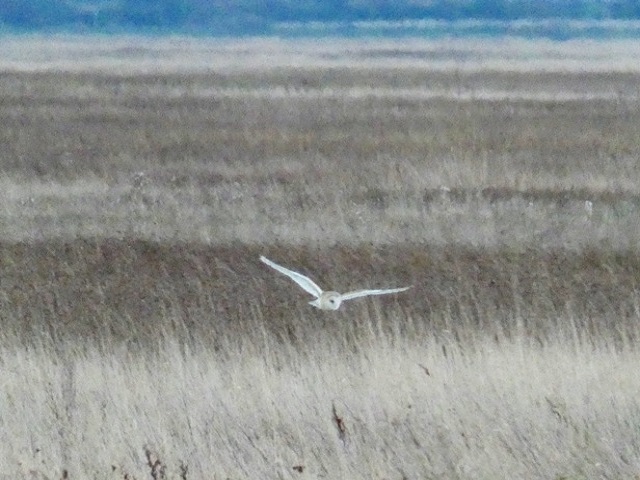
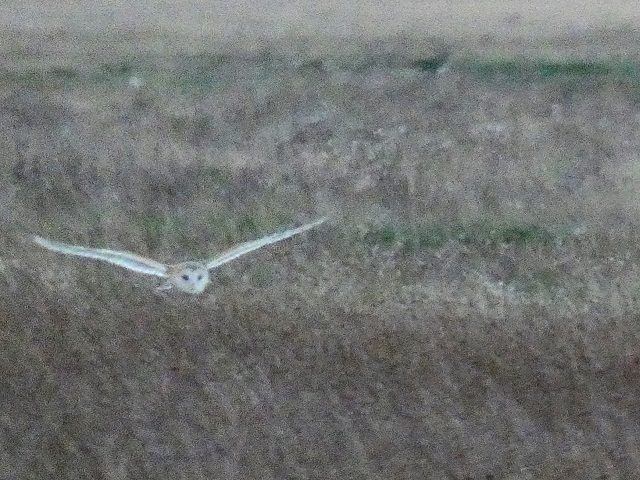
New member Ellie Thomas kindly sent in this magnificent photo of a Hoopoe she saw on a holiday in Praia da Luz, Portugal. She spotted it right outside her apartment, and fortunately she had her camera with her. I wonder when one will turn up on Wirral again?!
On a recent trip to Lunt, in Sefton, Bill Wonderley photographed this Snow Goose, which was in amongst a flock of Pink-footed Geese.
Following on from the entertaining talk by Jeff Clarke on New Zealand comes news of the winner of the New Zealand Bird of the Year 2021 award. Somewhat controversially, the title was given to New Zealand’s only native mammal – the Long-tailed Bat. The result has ruffled a few feathers amongst the birding fraternity, but it was given to draw attention to this special, critically threatened species!
Barry Curnow told me of a recent Goldcrest in his garden. The Goldcrest is Britain’s smallest bird, weighing on average just 5-7g (¼ oz). Despite their tiny size, Goldcrests are highly migratory, with a large influx of birds from Scandinavia and the near-Continent, arriving on the east coast of Britain every autumn. Immigrants arrive in Britain from late August through to early November, departing the following March and April.
Talking of migration, give a thought to those Grey Herons flying overhead at this time – they might be going further than you think! It is easy to assume that they are birds moving between favoured fishing areas but in fact these herons could be on migration. It is well known that northern populations move south as their breeding areas begin to freeze, with some Scandinavian birds crossing the North Sea for the relatively balmy conditions that Britain and Ireland have to offer. Ringing recoveries show that birds from Norway were mainly found in the north of Britain while those from the Netherlands being mainly found in the south.
Hugh Stewart




Numbers of Egrets have been increasing at Burton Mere Wetlands over the last month, with 5 Cattle Egret plus at least 30 Great Egret on 28th September! There are also 3 Spoonbill still around, mostly seen on the flashes at Parkgate.
You may remember that in June I suggested that you kept a look out for Rosy Starlings, following an influx into the UK. Well, Bill Wonderley indeed found a juvenile Rosy Starling on a trip to Llandudno in September. It is more difficult to pick out from the Common Starlings it usually associates with when it is in this plumage, so a good scan is required to identify one. This species seems to like north Wales, with several birds having been seen over recent years.
Bill also caught this nice image, at Conwy RSPB, of a Grey Wagtail in typical feeding mode, picking little insects off the water and vegetation. I think they are really smart looking birds.
However, the most impressive photos have to be the flight shots of the now famous Black-browed Albatross. The pictures were taken by Alison Davey’s sister Rachel Lowry, when they visited Bempton Cliffs together recently. Given the name “Albert” by birders, this magnificent bird has been present there for several weeks amongst the numerous Gannets. Well known for wandering around the southern oceans, Albert is clearly lost here in the northern hemisphere, but seems to be surviving well. As the Gannets now desert their cliff nest sites, Albert is also likely to move on – but where to? And will he return next year?
Hugh Stewart




Bill Wonderley obtained this wonderful photo of a Cattle Egret from the new Border Hide at Burton Mere Wetlands. It had been reported along with 19 Great Egrets and several Little Egrets!
At the same site, a friendly Pheasant posed on a fence for me. It may be a marmite bird, but they are colourful!
Paul Rowland also had a close encounter, with a juvenile Herring Gull. A bit too close for his car – the bird left its calling card!
My garden is still quiet as far as birds are concerned, although I am sure this will change when autumn creeps in. However, the Buddleia has been teeming with butterflies in the recent sunny periods, especially Red Admirals.
Talking of autumn, Barry Curnow saw a skein of Pink-footed Geese overhead on 5th September. These early birds were probably non-breeders, and numbers will continue to build up over the next couple of months.
A trip report on our visit to Hilbre has already been posted – we hope you enjoyed reading it. We have added a couple more wader photographs from the day for you to see.
Hugh Stewart






Wirral has witnessed 2 different American species over the last couple of weeks or so. Intrepid Bill Wonderley managed to catch up with them both!
First, a Long-billed Dowitcher flew into Burton Mere Wetlands. This is a dumpy, long-billed (unsurprisingly!) wader, looking like a bit of a mix between a Snipe and a Bar-tailed Godwit.
Then an American Golden Plover turned up on Hoylake Beach, which is a slightly smaller, slimmer version of our own Golden Plover.
On another recent birding trip, Bill saw three Jays together at a feeding station. I can only remember seeing single birds or very occasionally a pair together, so I think it is unusual to see a group of three. Maybe they were a family party?
Not so rare, but while out for a late evening walk with the dog, I saw this Heron on a roof at the end of our road. I have noticed one flying low a few times this year around here, so I suspect there is a garden pond nearby – I hope the owners don’t mind losing a few fish or frogs!
The start of the Club’s new Programme in September is approaching fast. It will be great to be able to hold our meetings with some degree of normality again.
Hugh Stewart




It was wonderful to finally be able to hold our first Indoor Meeting for over 16 months. Members thoroughly enjoyed the talk from Chris Tynan on the Birds of Liverpool Bay, and liked our great new venue at the St Bridget’s Centre.
Paul Rowlands reports that the leucistic Starling is still present at Leasowe. He also caught the beautiful rainbow colours of a typical bird. Such an underrated bird.
Walking towards the Old Baths car park at Parkgate, I saw this large caterpillar on the road. I think it is a Drinker Moth, but I stand to be corrected.
Talking of Parkgate, I know that parking spaces can be an issue there, especially at high tides. But this example was a bit over the top – literally!
Bill Wonderley has just returned from a British Isles cruise, and he managed to capture the attached photograph of Gannets, flying over the ship.
Sorry it is short notice, but the annual Wildlife Art Exhibition is on at Gordales from Friday 30th July until Sunday 1st August. Open from 9.30am until 6pm on Friday and Saturday; 11am until 5pm on Sunday. Free entry, it is well worth dropping in to see the exhibits.
The Club’s meetings take a short break now during August, but in September our new exciting programme will start up again. We hope to see you all again then.
Hugh Stewart
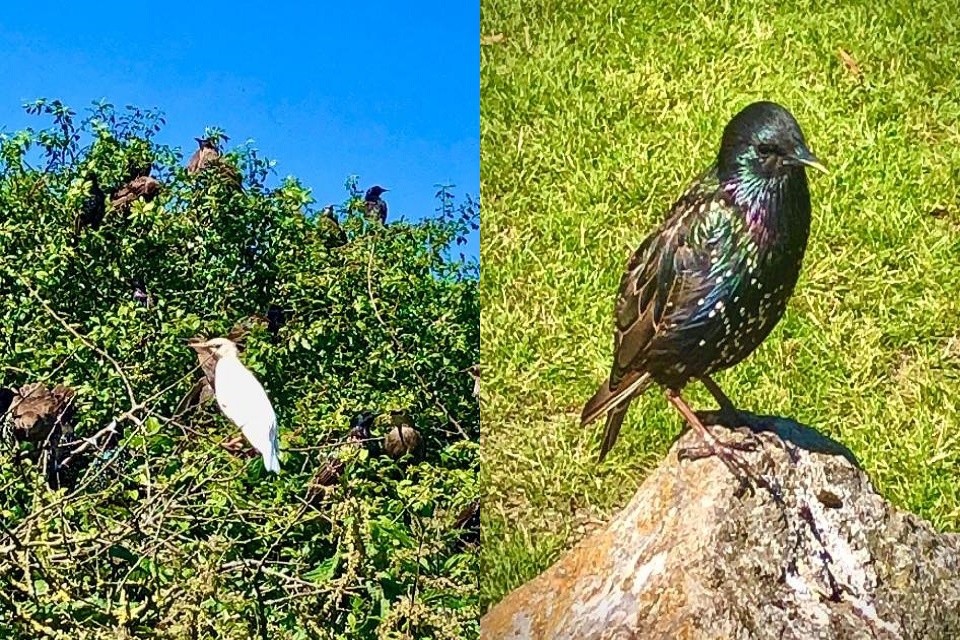
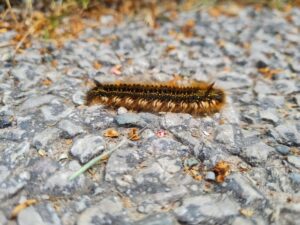


Bill Wonderley reports that he recently spent four days, with three other birders, in the Cairngorms National Park area of Scotland.
He told me “Although we failed to see Ptarmigan and Dotterel, we did see Crested Tit, Wood Warbler, Slavonian Grebe, Red-throated Diver, Tree Pipit and Hooded Crow. In addition, I managed to photograph Osprey (Loch Insh), Black-throated Diver (Lochindorb) and Ring Ouzel (Cairngorm Mountain Visitor Centre). The Cairngorms National Park is well worth a visit, with its mountains, lochs, forest paths and wildlife hotspots.”
I concur totally with Bill!
Last time, I suggested keeping a look out for a Rosy-coloured Starling. Well, Paul Rowland didn’t spot one, but he did see this all white Common Starling at Moreton Shore! I cannot make out a pink eye, so I think it is a leucistic bird lacking pigmentation in its feathers, rather than an albino. What a striking bird! He also took a photo of a brown, juvenile Common Starling as a comparison.
There have been many discussions recently on Twitter and elsewhere on the status of the beach at Hoylake. If you are interested in reading more, there is an interesting article on Richard Smith’s website. The link is:
http://www.deeestuary.co.uk/news.htm?s=09
We may well be able to judge more for ourselves at the next Field Meeting starting at Dove Point.
Hugh Stewart

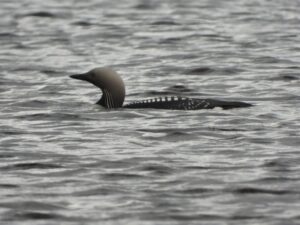
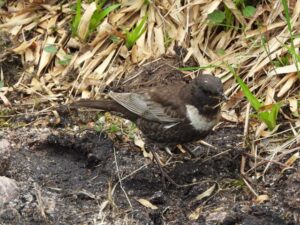
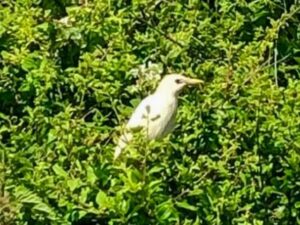
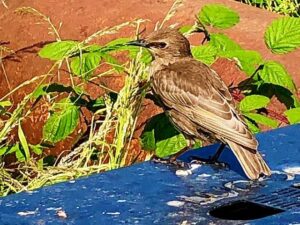
It was so nice to be able to meet in person again for our first field meeting in well over a year. We enjoyed a wonderful walk around Parkgate, not just looking out for birds but enjoying the company and generally catching up. Perhaps the highlight was some really close views of at least 2 different Marsh Harriers off the Prom. You can read a fuller account of the day in our Field Meeting Reports section.
Bill Wonderley made a visit to South Stack on Anglesey and as well as the auks and gulls, he found this wonderful Chough – surely our most attractive member of the crow family with those bright red bill and legs. Then on a short holiday to Suffolk, Bill found a splendid Spoonbill – in contrast to our visit to Parkgate!
I noticed a male Blackbird feeding 4 young in my garden. One of the fledged birds is shown below, looking quite spotty, and they can often be mistaken for thrushes at this time of year. Dad will have to work hard to satisfy these growing birds on his own, but they all looked healthy. Also, on the small green at the top of our road we found a young Jackdaw. It lacked a tail and seemed reluctant to fly, so probably it had fallen from a nearby nest. I felt sure that its parents were close-by, so we left it alone.
Something to look out for on your walks is a Rosy Starling over the next few weeks. There has been a large influx of this species into Western Europe, including several reports in the UK. They often associate with Common Starlings, so it may be worth scanning any local flocks for a pink and black bird!
Hugh Stewart



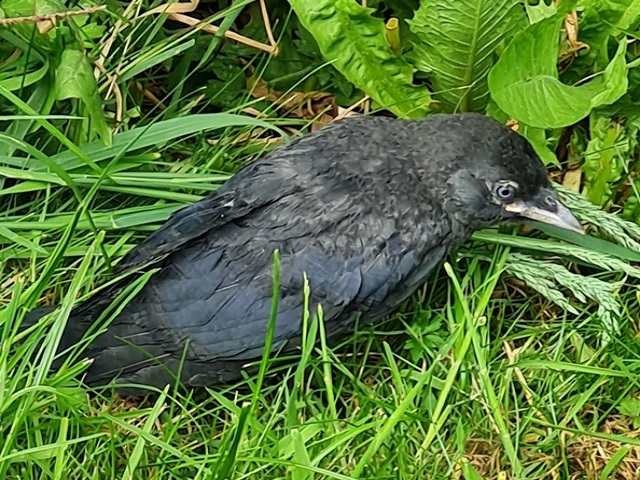
On a walk around Royden Park last week, I came across two Moorhen chicks. Although still fluffy, black balls, they were already quite independent, climbing over the lily pads in search of food items while the parents looked on. The youngsters did return to the nest though for a bit of reassurance from mum and dad. A separate pair of Moorhens were on a nest on the floating platform on the opposite side of the lake.
Bill Wonderley made the trip to World’s End and was rewarded with some great birds, including both Black and Red Grouse as well as Wheatear. He also had a distant view of a Cuckoo, perched in a tree and being mobbed by Pipits. I haven’t made it to this wonderful spot for the last two years now, so I am very jealous. Next year!
Mike Hart has drawn our attention to an interesting and thought-provoking article in The Lake by Richard Smith. You can read more about this on Richard’s website:-http://www.deeestuary.co.uk/news0421.htm
Those of you that couldn’t make last Thursday’s Zoom presentation, I have to say you missed a really good presentation from Dr. Rob Williams, taking us on a journey through Peru from the Pacific to the Amazon. Rob was clearly very knowledgeable, but the talk was pitched to be accessible to everyone. The quality of his photographs covering birds, animals, habitat and historic sites was superb.
Finally, you will remember the photo by Stewart Smith of a Redshank on a waste-bin. The joint best entries for a caption (as judged by me!) were:-
1 – This is a rubbish nest site.
2 – No, I refuse to move.
Groan!
Hugh Stewart

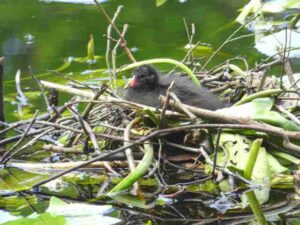


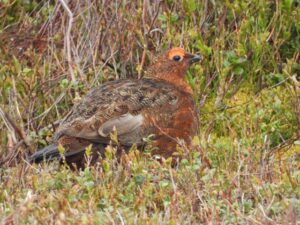

I don’t know what effect the unsettled conditions we have been experiencing will have on this year’s breeding results. The cool conditions certainly have made the Hawthorn late in flowering. I noticed that the buds were only just opening this week, but in my experience they are normally out in April, despite its common name of May blossom.
Bill Wonderley found this splendid male Ruff at Marshside, sporting the amazing breeding plumage that gives the bird its name. The colours can be variable, from white, through browns, to lots of black. Sadly we do not often see this plumage, as the passage birds we have on Wirral have not moulted out of their non-breeding plumage. The female of the species is more accurately called a Reeve, but doesn’t acquire this colourful plumage.
Bill also photographed a Reed Warbler at Burton Mere Wetlands, back from its winter stay in sub-Saharan Africa.
Paul Rowlands saw a Grey Heron on Roydee Mere in Royden Park, undisturbed by the dog-walkers and fishermen!
I didn’t notice until it was too late to inform you all, but the 2nd May was International Dawn Chorus day. I am sure many of you were up early to listen to the avian cacophony! We could organise a Dawn Chorus meeting next year. We don’t have to start at the crack of dawn, but obviously it would require an early start. Let us know if you are interested.
Finally, the Club has been contacted by Eureka! The National Children’s Museum in Halifax. They have asked us to help contribute to a new visitor attraction aimed at 8 to 14 years olds in particular (and younger children and families in general) at the existing Spaceport site at the Seacombe Ferry Terminal, and which is due to open in Summer 2022. We were happy to assist and have provided information on migrant birds that can be seen on and around Wirral. You can read more at https://www.eurekamersey.org.uk/ and we will keep you updated on progress.
Hugh Stewart




John Gill has just heard from a friend who does a lot of voluntary work with various nature conservation groups that they heard a Bittern “booming” today at Lunt Meadows, a wetland trust developed over the last few years in Sefton. Volunteers, including his friend, have planted reed beds there over the last few years and the project has been very successful, but this really is the icing on the cake. Members will recall we had a successful visit there a couple of years ago, with a Barn Owl being the highlight. There has also been a booming Bittern at Burton Mere Wetlands this spring, which just shows how providing the right habitat will bring in the birds!
The photo of a Bittern below is not from Lunt or BMW but my image from a Club trip to Martin Mere in February 2012.
The Rock Pipit photograph was taken by Bill Wonderley 14th April on the Great Orme. Rock Pipits are usually found on rocky shorelines. Compared to the more common Meadow Pipit, they tend to be a darker, greyer colour above and below, with dark legs.
New member Stewart Smith sent us this photo taken on the promenade between Egremont and Vale Park, of a Redshank sat on the lid of a refuse bin! Redshanks sometimes perch on field posts to sing when they are on their breeding territories, so maybe this bird is using a makeshift song-post! We thought the image is certainly unusual and rather comical.
Would you like to submit a witty caption to accompany the image?! No prizes, just for fun. Email Bill or me ([email protected]).
I found this tiny Chiffchaff on our patio last week, most probably from a window strike, perhaps evading the local Sparrowhawk. There had been a calling bird around our back garden for a week, so I would guess this was the same bid. I picked it up and placed it in a covered box in the kitchen. It was so light, typically they are less than 9g! Luckily it recovered quickly and when I checked 15 minutes later it flew off strongly back to the trees. What I assume is the same bird is still calling as I write so presumably it survived its ordeal.
Thank you to all the Members that attended Thursday’s wonderful talk from David Hollis on the birds and nature of Shetland. It seemed to be very well received, I know I really enjoyed it. The numbers we are getting at the meetings are truly encouraging, although of course we cannot wait until it is safe and practical to meet up together again.
Hugh Stewart




Migrants are starting to increase in numbers now. A handsome male Ring Ouzel was present at Leasowe at the end of last week and was photographed by Bill Wonderley. This thrush species is the upland equivalent of the Blackbird, and winters in Southern Europe, North Africa and Turkey and breeds in the hills of Scotland and northern England. So it will soon move on. While superficially similar in appearance to the Blackbird, they sport a dashing white gorget on the chest, the males especially. They also have subtle silvery edges to the wing feathers, and typical of longer distance migrants, they have longer wings. Females are browner and less contrasting but can be readily identified still given a reasonable view – but beware of female Blackbirds with pale throats! He also saw a male Wheatear there.
Sightings of Swallow, Sand Martin, White Wagtail and Red Kite have all been reported in the last week. The migration pace will quicken over the next month, so keep a good look out on your daily walks.
Jean Eymond had a pair of Blackcaps on the feeders in her garden on Friday. It is difficult to be sure if they are potential, local breeders, or just passing through. She hopes the former! She is still waiting to see if the Bullfinches she enjoyed last year return.
Margaret and Jim Anderson found several Common Toads on the boardwalk at Red Rocks. One individual had a red mark on it that according to the Wirral Amphibian and Reptile Group is a flesh wound – perhaps caused by a bird seeking a meal. They told me that eggs are visible under the wound, showing this is a female. The Toad clearly escaped, but its chances of surviving are small sadly. There is a healthy population there though, so one loss should not be significant.
Following on from Debra Williams’ videos last time, here is another one of a pair of Mute Swans mating. This was on 8 March in the docks in Liverpool where she lives. Debra also saw (but didn’t film) Peregrines mating even earlier on the 26 February. They nest on the Anglican Cathedral in Liverpool.
https://twitter.com/wordsanddeeds1/status/1368910484737523712?s=19
Paul Rowlands captured some beautiful images of Mandarin Duck at Arrowe Park. Whatever your thoughts on their status in the UK, there is no denying how photogenic they are.
Joyce has informed us of an Osprey nest at Foulshaw Moss, a Cumbria Wildlife Trust site, with 2 live-streaming webcams. These can be viewed at:
Hugh Stewart
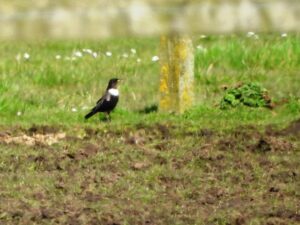

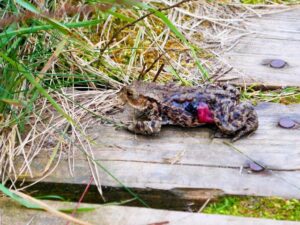


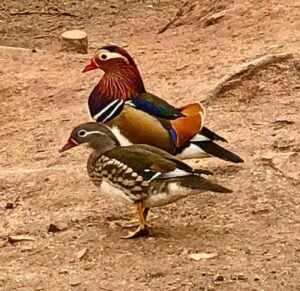
Welcome to the next edition of Hugh’s News – guaranteed to be Megxit and Covid free!
As expected at this time of year, migrants are starting to pass through our region in increasing numbers, with some moving on further north, maybe after a brief stop-over to feed up; and others staying here on Wirral to (hopefully) breed.
At the same time, winter visitors are beginning to leave us for their breeding grounds. The Pink-feet Geese that entertain us with their daily fly-overs are reducing in numbers daily.
Graham Jones (RSPB BMW) has reported that one of the male Hen Harriers that has wintered on the Dee has a white colour ring with black lettering. It turns out that it’s a Dutch bird that was ringed on the nest on the island of Texel in May 2019. It shows what a draw the Dee is for birds. We wish it a safe journey back to the Netherlands.
Another species soon to be leaving us is the Merlin. Peter Ham visited the Riverbank Road car park which gives a great elevated view across the marsh, and noticed this smart male bird initially perched close in, and then managed a lovely flight shot as it moved off. This bird will soon be heading for the uplands somewhere to start breeding.
Yellowhammers were relatively easy to see along the hedgerows of Wirral just a few years ago. Sadly their numbers have reduced in recent years, as have many farmland bird species. A few are still clinging on around Thornton Hough though, and Bill Wonderley found this bright male bird there. Someone has been scattering seed down, presumably for the Yellowhammers in particular although other birds will take advantage! A lack of winter food is thought to be one of the main factors affecting this species, as farmers often plough the autumn stubble now in order to sow winter cereals.
Related to the ringed harrier story above, Debra Williams has drawn our attention to an interesting article that she was invited to write for the February 2021 issue of the Hen Harrier Action newsletter, about Hen Harriers on the Dee estuary. It’s downloadable as a PDF at: https://henharrierday.uk/news
Debra also filmed four Jays flying over her Liverpool allotment on 8th March, making ‘wink wink’ Pink-footed Geese calls. It is not well known but Jays, members of the intelligent crow family, can mimic birds, animals and even humans. You can watch her video at: https://twitter.com/i/status/1368911991901929480 (We think you should be able to watch it even if you do not have Twitter).
She also had great views of a female Sparrowhawk kill (a collared dove) in the road on 5th March. You can watch it at: https://twitter.com/i/status/1367838856498839557 Again, we don’t think you need to have Twitter WARNING – this is slightly graphic, but it depicts true nature. These were captured on a phone camera but are still fascinating to see. They just go to show how we can still enjoy nature even close to a city centre.
Hugh Stewart

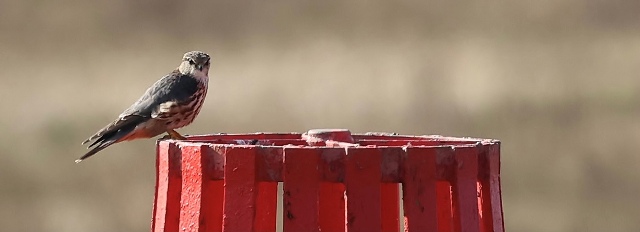


How upbeat a few mild and dry days in a row made me feel! Not quite on a par with Namibian skies that Keith Offord showed us on Thursday, but welcome nevertheless! There has been a definite feeling of Spring over the last week, not only with the weather but also the emerging flowers. The birds know the change is coming too.
I have heard Blackbirds, Song and Mistle Thrushes, Robins, Dunnocks and Greenfinches all in song recently, plus a single Skykark. A pair of Starlings is nest-prospecting in the (damaged) eaves of a neighbour’s house, the same hole as for the last 3 or 4 years. The first Avocets arrived back at Burton on Tuesday, always one of the first summer visitors to return. They will not start to nest for a few weeks yet and numbers will continue to build up, but it is another sign of the coming breeding season. Other early migrants will soon start to appear, like Sand Martin and Wheatear. Please let Bill or me know what summer visitors you are particularly looking forward to seeing again!
[Note my new email: [email protected]]
Bill saw a party of 12 Crossbills in the pines at Ness Gardens. His attached photo is of a green female. More common in north Wales pine forests and woods such as Clocaenog. Crossbills are quite a rare bird on Wirral, and this party has proved very popular amongst local twitchers and photographers! Their crossed bills are designed to extract seeds from conifer cones.
Following on from the piece from Martyn Jamieson on White-tailed Eagles last time, he rubbed salt into the wound before the Zoom meeting by telling us that a pair of eagles were nest building close by his home! I have to settle for humble Robins!!
Finally comes a report of two birds stuck together in a Wirral garden. I think they were Velcrows! [Sorry, I’ll get my coat!].
Hugh Stewart

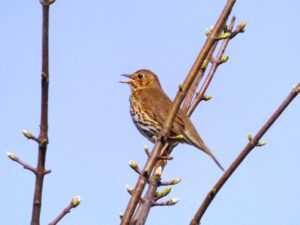


The Snow Buntings continue to provide a great display on the beach along Hoylake Prom. Margaret and Jim Anderson caught up with them this week. I must get down there before they disappear!
Brian Bishop took this photo of a raptor perched in a tree in West Kirby. At first glance, he thought it might be a Peregrine. However, a closer look indicated that it wasn’t that species, but rather a Red-tailed Hawk, a North American species! The remnants of jesses can be made out on one leg, indicating this is an escaped falconer’s bird. In fact this particular bird has been present in West Kirby since March 2013, an incredible 8 years. It is obviously feeling at home, often terrorising the local feral pigeons and covids. The next time you visit the town, look carefully at the roofs and trees around Morrison’s!
Bill came across the small flock of Brent Geese between Hoylake Lifeboat Station and Leasowe groyne. They are becoming a regular feature off-shore here, although the majority of the flock tend to remain loyal to Hilbre and around.
How did you get on with the Big Garden Birdwatch? My results were nothing spectacular, with no species of note – “just the usual”! I still enjoyed the hour, and the data is all useful. Sods Law, the cold weather this week has increased the activity on my feeders significantly. If I did a count today, I know I would get much bigger numbers!
Following on from the Big Garden Birdwatch, I bet none of you could beat member Martyn Jamieson’s star bird. OK, so he does live by Loch Bee in South Uist in the Outer Hebrides, but seeing White-tailed Eagles from your house must be amazing. The first photo of a single Eagle is Martyn’s image. The second photo was taken by his friend John Love when 12 eagles were seen together on the frozen Loch feeding on a dead swan. What an incredible experience that must have been! John was instrumental in running the original White-tailed Eagle introduction scheme on Rum many years ago. A new White-tailed Eagle reintroduction programme is well underway on the Isle of Wight, and there are new proposals for a similar project in Norfolk. But if you really want to see these magnificent birds, you’d best go North! When we are allowed, of course!!
A final reminder that Bill will send out the meeting details for Keith Offord’s Zoom talk (on Thursday 25th February) in the next week or so. Keep a look out if you wish to join in.
Hugh Stewart




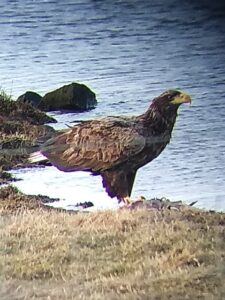

Our first Zoom Speaker meeting on Thursday seems to have been well received by members, judging be the feedback the Committee has seen. The technology worked – thank goodness – and 38 members signed in for a lively presentation by Mike Leach. So we can look forward now to the next one in February featuring Keith Offord. Details will again be sent out a few days before the day.
Peter Ham has sent in this wonderful picture of a male Kingfisher putting on a great display in front of him during a walk along Leasowe prom, by the groyne. You can identify it as a male from the all black bill; females have a reddish base to the lower mandible.
Peter also sent in winter-plumaged Common Gull from the same place and time. He thinks they look more attractive than the larger Herring and Black-back Gulls seen along there, and I tend to agree with him. I think it is the rounder head shape makes them look less fearsome. A few days later Peter came across the small flock of 8 Snow Buntings still present on the beach near the Lifeboat Station. I love this composition of three of the birds.
Bill’s contributions feature a Redwing beside the Parkgate Old Baths car park. The sun has illuminated the bird beautifully to enhance its red and chestnut hues. He also managed another photo of a male Goosander at West Kirby Marine Lake, which continues to hold a nice mix of Goosanders, Red-breasted Mergansers and the occasional Goldeneye.
In other bird news, 17 Purple Sandpipers were roosting on Hilbre, a good number for this speciality wading bird compared to recent years. Easier to see are the 5 birds on the pontoon at New Brighton Marine Lake over the high tide yesterday! The Bittern is still being reported flying in to Neston Reed Bed at dusk most evenings.
Hugh Stewart

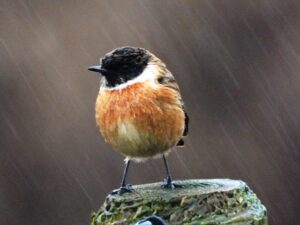

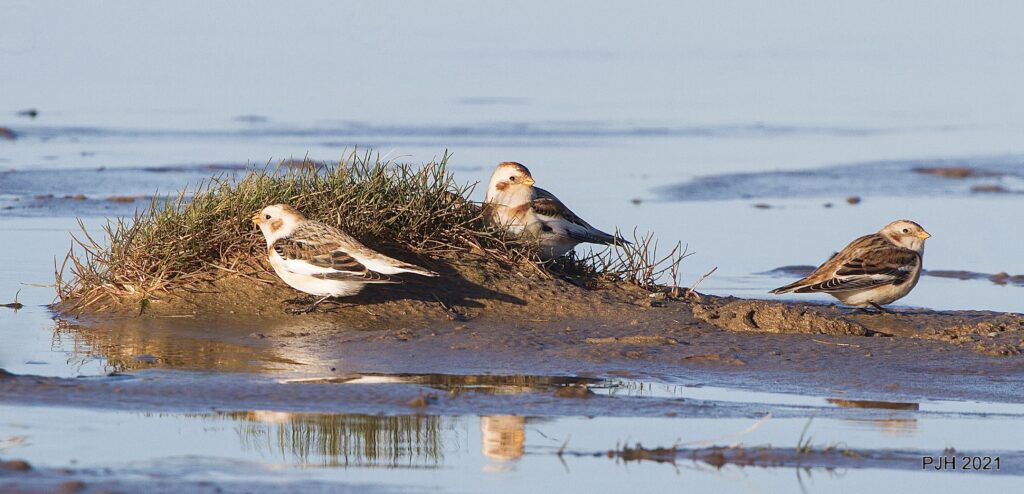
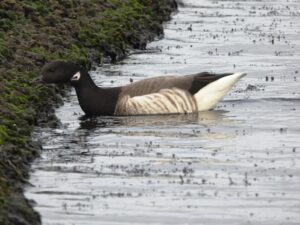

Happy New Year to everyone, I trust you had an enjoyable albeit maybe slightly different Christmas. I have had to re-write this first paragraph following the announcement of the new lockdown! However, I am still trying to remain optimistic that the roll out of the vaccines will improve the situation in a few months. We adapted to the first national lockdown, and I am sure we will get through this one too.
In the meantime, we have organised a series of monthly Zoom meetings with guest speakers giving their presentations on-line. This may not give us quite the same social buzz as an indoor meeting does, but we hope you will join in and enjoy them. The meetings will be on the 4th Thursday of each month at 7.30pm until further notice, the same as when our Indoor meetings would be held. Bill will be sending out details to members on how to join in around a week beforehand, so check your Inbox periodically.
The birds don’t know there is a pandemic of course (although there have been a few cases of Avian Flu identified in the UK in wild and farmed birds!), so we can still admire them on our local health walks. I know some of you will have started a new Year List already, while others simply enjoy seeing the birds in the garden or local area. As long as it brings a smile to your face, that is the key thing!
Bill is on a roll with Kestrels, one of our common raptors and always nice to see. This one was near Landican Lane. The tail appears blackish, so I am unsure if it is a male (usually sporting a grey tail) or female (brown tail), so maybe it is a young bird not fully moulted into its adult plumage. Bill also found a rather bedraggled looking Stonechat in the rain at Burton Mere Wetlands. There has been a flock of up to 8 Snow Buntings moving along the shoreline between Leasowe and Hoylake, and Bill snapped one of them. He also got close to a pale-bellied Brent Goose feeding on the seaweed on the walls of West Kirby Marine Lake.
Margaret Anderson was chuffed to see a female Great-spotted Woodpecker in her garden (all black cap with no red patch on the nape). Margaret also reported this plump game bird in heavy moult on Christmas Day!! The lack of feathers makes it difficult to be 100% certain of the identification!
I hope you enjoyed the challenge of Jean Eymond’s Quiz. Bill sent out the answers a few days ago – let him know if you missed the email. How many of you got all the answers correct? Be honest now! Well done if you did.
Stay safe and enjoy your walks. Remember, the days are getting longer now and spring will soon arrive!
Hugh Stewart






Some of you may be aware already, but the annual Big Garden Birdwatch will take place over the weekend of 29th – 31st January. So now is a perfect time to make sure your bird feeders and tables are stocked with a variety of food to encourage a good mix of species. Then we need to hope for a spell of colder weather for a few days leading up to the weekend to bring more birds into our gardens. Not too cold though! Many birds are still feeding out in the fields and woods with the continuing mild conditions.
Bill has sent in some lovely photos from his Wirral wanderings. At Parkgate, a Mistle Thrush was with Blackbirds and Fieldfares in a hawthorn still bearing some berries. A few of the thousands of Pink-foot Geese on the marsh were unusually close to the shore path. Normally they are shy birds. He spotted a Black Swan a few days ago at the Caldy Wildfowl Collection. These are not native birds, but they do look very regal.
A smart drake Goosander was on West Kirby Marine Lake. Another photo shows how calm the water was – it is not often that the water is still enough to see the reflections of the houses. A little further afield, a Kestrel posed for Bill on Anglesey.
I don’t know if it was the same day that Bill was in West Kirby, but I enjoyed a beautiful sunset at Burton Mere Wetlands on a calm day.
A few weeks ago, I mentioned the reintroduction of Beavers into Cheshire. Here is a link to a video showing them being released into their new home. The reserve is not open to the public yet, but we will watch out for further news and update you.
Finally, we have to end with a seasonal Robin! Well, it wouldn’t be Christmas without one!
Best wishes to you all from the publishing team. We will be back in the New Year!
Hugh Stewart




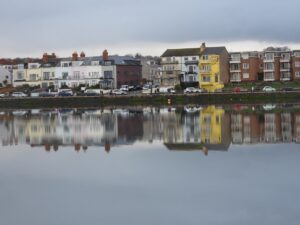

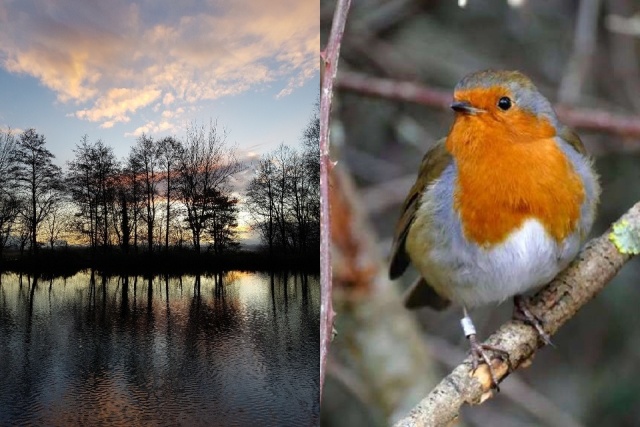
I would like to add my thanks to everyone that joined in the Zoom meeting. It will be the way to go for the next few months!
As we slowly drift into winter, the birds have started to return to my feeders in greater numbers. Joyce had a male Blackcap and a Jay in her garden. No photos, but two nice birds for her to see. Has anyone else had a wintering Blackcap turn up in the last month? Recent studies have shown that Blackcaps wintering in the UK bred across Europe, their breeding range spanning 2,000 km from Northern Spain to southern Poland. Interestingly, Blackcaps wintering in the UK arrived on their continental breeding grounds almost 10 days earlier than other individuals that also bred in that location but which wintered in southern Europe or North Africa.
Bill photographed this endearing Little Owl enjoying the sunshine at its regular spot at Burton Point. A little group of Redshanks were at West Kirby.
Barry Curnow snapped a Mistle Thrush at the top of a conifer. Judging by the leaden sky, it was living up to one of its old traditional names of “Stormcock”. He also told me of good numbers of House Sparrows in the car-park of ALDI Prenton! They do not seem to be scarce around there at least. The photo is of a cock bird in his garden. There has been a massive decline in these once common birds in recent years, primarily due to the lack of food for chicks and first winter birds.
For those that missed the Zoom Meeting, the new hide at BMW that the Club made a donation towards is now complete, and it should be open to all in the New Year, when the new paths and fencing are finished. It will be called “Border Hide”, as the English-Welsh border just about runs through it! Here is a sneak preview of what it looks like inside. There is also a small herd of Highland Cattle on site to add to the interest!
Hugh Stewart





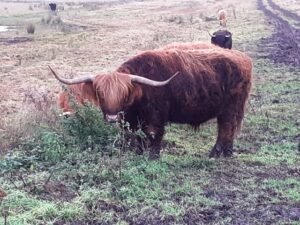
Following on from the journey of the Whooper Swans from Iceland to Hilbre, I covered in the last Hugh’s News, now comes news of a record breaking migration. A Bar-tailed Godwit has been recorded flying non-stop from Alaska to New Zealand, a distance of 7,500 miles! It took the bird 11 days to complete this staggering feat, at speeds up to 55mph. Then of course in a few months time it will make the return journey back to its breeding grounds. It makes me feel tired just thinking about it!
Barry Curnow has told me that on the 1st of November 2019 he saw his first small flock of Brent geese fly over the house, 11 in total in a floppy V formation and not calling. Then also on 1st November this year, he saw a similar group of 11 in all, flying in the same formation and again not calling. Over the house and at about the same low height! How’s that for a coincidence!
This black and white goose has been increasing in numbers on the Dee in recent winters, but are not often seen inland. Maybe the birds Barry saw were just arriving from their breeding grounds in the high Arctic tundra. They are more often to be found off Hilbre or around the Red Rocks area.
Once we are allowed more freedom in travelling around, it may well be worth visiting Parkgate. There have been two male Hen Harriers, together with ring-tailed Hen Harrier, several Marsh Harriers, Merlin, Peregrine and Short-eared Owl. Bill also saw this brightly coloured and obliging Pheasant on the marsh.
Bill also caught up with one of two Snow Buntings that were present near Leasowe lighthouse.
I reckon that Pintail are the most elegant of our regular ducks, and Peter Ham caught this amazing shot of a flock off Sally’s Cottage at Thurstaston. This is a regular spot to see them, especially on the gutter on an incoming tide.
Finally, the new Hide at Burton Mere Wetlands, that the Club made a donation towards, is nearing completion. See Bill’s photo.
More news on this in our forthcoming Zoom meeting, and in the next Hugh’s News.
Hugh Stewart






Christine has let us know about a lovely early-morning walk across to Hilbre that she made with some friends. One of the group, Myra Brown, caught a beautiful composition of 16 Whooper Swans flying overhead in the breaking sunlight, possibly on their way to Martin Mere. These wild Swans make the trip from Iceland to the British Isles in a single flight. We usually have a few wintering on the Dee too.
Christine also saw a nice mix of birds a few days later walking beside Meols beach, and obtained a lovely portrait of this Redshank with its reflection; and a small group of grey Knot. She also saw a big flock of Shelduck, and a Little Egret.
Bill was contacted by someone asking how many gull species could be seen on Wirral. As I counted them up, I was absolutely amazed at the answer I came up with. The most commonly seen species are Herring Gull and Black-headed Gull, with supporting Lesser and Greater Black-backed, and Common Gulls. Increasingly, Mediterranean Gulls are now seen.
Strong winds may bring in Little Gull and Kittiwake, and sometimes an even more scarce Sabine’s Gull.
Uncommon species may also include Yellow-legged Gull or Caspian Gull. In cold winters, a white-winged Iceland and Glaucous Gull could pass through.
Occasional real rarities like Laughing Gull and Bonaparte’s Gull have turned up. These are both North American birds that can get blown off-course across the Atlantic. It these less common species that keen bird watchers keep a special look out for amongst the more common relatives!
So that’s 15 species – and I may have missed one or two. Has a Ross’s Gull been seen on Wirral? So you can see there is far more variety to gulls than one might think at first!
We have finally received a couple of entries for the Pink-footed Geese photo challenge! A big “Thank You” to Barry for forwarding his contribution. A special mention goes to Joyce for spotting some flying over while she was playing golf – a double birdie! I finally managed to snap some myself late one afternoon, flying back towards Parkgate to roost. No prizes will be awarded, just the glory of being mentioned in dispatches!
Hugh Stewart

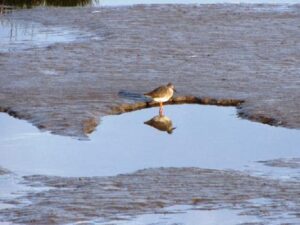
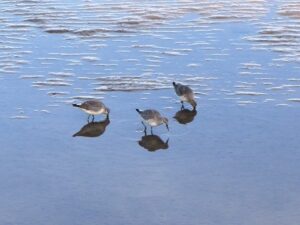




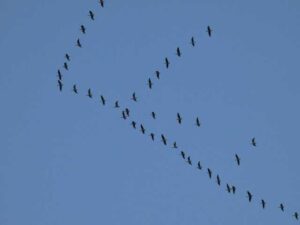
During a brief spell of sunny warm weather, I saw a Clouded Yellow butterfly just sitting on some rough grass. This amazing butterfly is mostly a migrant to the UK, originating from North Africa and southern Europe, with numbers varying greatly from year to year. A few have also overwintered in the UK in recent years another sign of climate warming. It is incredible to think that such a delicate insect can fly across the Channel.
Joyce was chuffed to see 4 Redwings in her garden feeding on Pyracantha berries! Along with Fieldfares, winter thrushes don’t usually come into gardens until later in the winter, when the hedgerow berries have been stripped or the weather turns much harsher.
Bill came across a lovely female Merlin perched on a post at Hesketh Out Marsh near Southport.
Peter came across a Guillemot off-shore between Thurstaston and Caldy. From his photo, it looks like a juvenile bird, going by the grey smudges on its cheeks.
Jean saw a Sparrowhawk in her garden, no doubt touring the local feeding stations!
No-one has submitted a photo of Pink-feet Geese so far – the challenge is still out there! And I haven’t taken one myself, so I have added a picture of moulting Canada Geese instead!
Hugh Stewart




Just when things seemed to be going in the right direction with Covid, we have had a set-back. Hopefully this situation will not last too long.
There is definitely an autumnal feel to the weather now – I had a frost on the car windscreen last Sunday! This change in conditions is starting to show in the birds we might see, as the breeding migrants continue to depart and the winter birds arrive. Pink-footed Geese numbers rise daily with at least a couple of thousand already present on the marshes. I have not managed to catch a good photo of a skein flying overhead in that classic V formation, so my challenge to all you photographers is to try to obtain one for inclusion in the next Hugh’s News!
I keep mentioning Egrets in these posts, as they often provide interesting stories and photo opportunities. By coincidence, I have three separate items on Egrets this time.
Bill took a nice illustrative photo that shows the size difference between Little Egret and Great White Egret.
Margaret saw lots of Little Egrets off Meols prom, seemingly sunbathing she thinks! But on the way to West Kirby there was a lonesome one who kept popping up from the sand dunes! It eventually took off in the direction of Heswall.
Great Egrets have quickly become part of the furniture on the Dee Estuary in recent years, but a whopping 39 were counted flying into the roost at the heronry at Burton last week!
I saw one Great White Egret catch and eat a fish in the reed bed, a regular spot for seeing them. Does anyone recognise the fish species?
Finally, the number of Cattle Egrets has built up to 10.
This week I gave a talk to children at Great Meols Primary School, on birds and the environment. They were very attentive, and I was pleasantly surprised by their knowledge. Arguably a better behaved audience than at WBC! It was a pleasure to help one of our local schools, and maybe inspire a few of the pupils to further an interest in birds, wildlife and nature.
Following up on progress with the new hide at Burton Mere that we donated to, the new boardwalk has been installed that will bypass the steep steps, and work is now beginning on preparing the ground for the hide itself. It is hoped to open the hide in November.
Keep smiling, stay safe.
Hugh Stewart




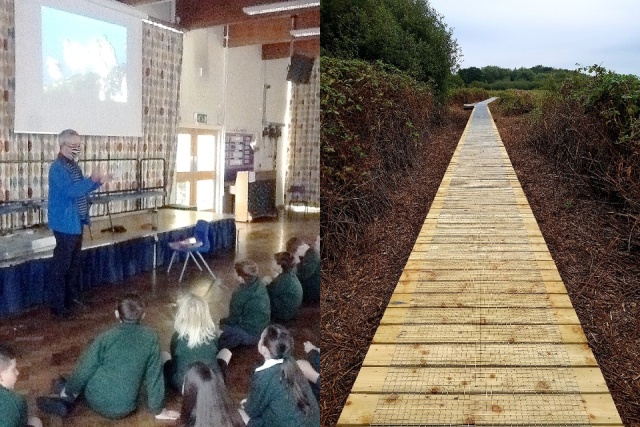
While Covid-19 restrictions still affect the Club’s activities, we are happy to continue publishing regular issues of Hugh’s News. They are currently being sent more frequently than normal, in an effort to (hopefully!) keep you entertained and informed. I should record that I cannot take all the credit for their publication. Together with the Newsletter (which has had to take a holiday), Bill and Jean are instrumental in their composing and editing; and various members contribute photos and (ideas for) articles. So a big thank you to everyone who has been involved.
I have just read a book on the rewilding project at the Knepp’s Castle estate in Sussex. It was a fascinating account albeit a little detailed in places! The location was notable this year for recording the first wild breeding of White Storks in the UK for around 600 hundred years. Coincidentally, Cheshire Wildlife Trust plan to release Beavers into Hatchmere Nature Reserve in Delamere Forest this October, 400 hundred years after their extermination! And there is a feasibility study underway into the possible release of Golden Eagles in Snowdonia. My personal opinion is that the latter project is unlikely to proceed as there is little natural prey such as Mountain Hares there.
Barry reports hearing a probable Red Kite above his garden, but wasn’t able to locate it to confirm its identification. He regularly sees them at his daughter’s home in Oxfordshire, so is familiar with the call.
Work has just started at Burton Mere Wetlands on installing the new hide that the Club made a donation towards. It is hoped this will be completed by November, and we will let you know when it is open.
Todays’ photos are:
Lapwing, Ruff and Black-tailed Godwit taken by Bill at Martin Mere WWT.
A pair of Magpies, juvenile Wood Pigeon, and juvenile House Sparrow in Barry’s garden.
A White Stork nest from Hugh – taken in Spain earlier this year, not Sussex!
Hugh Stewart







This last week has seen high tides, allowing some spectacular close views of waders at Hoylake as they were pushed in by the incoming water. Bill captured a beautiful mix of Ringed Plover and Dunlin, some of the latter still sporting their breeding plumage black bellies; and Sandwich Terns with a well-named Little Tern. Oystercatchers settled on the tideline, marching along as the water pushed them further in. I snapped a Lesser Black-backed Gull loafing on the water.
Bill found a very obliging, juvenile Cuckoo at Leasowe where it has been feeding well, before starting its long migration. Just how do these young, inexperienced birds navigate their way alone to sub-Saharan Africa and then back again next Spring, without the help of their parents to guide them? Incredible!
Brian visited Staveley nature reserve near Knaresborough in Yorkshire and was lucky to see 3 Otters fishing in one of the lakes. You can hopefully make out two of them in his photo – the head of one on the right, and the rump of another on the left. I have not heard of this reserve before but it looks like it is well worth a visit if you are passing the area.
The photo of a nesting Collared Dove was taken at Barry’s daughter’s house. Collared Doves normally have three or even up to six broods per year. The breeding period is typically March to September, but if enough food is available (which is largely seed and grain) then breeding will also take place in the winter months. No wonder they have become so common! The lovely portrait of a male Blackbird feeding a youngster was taken in his own garden. Slightly more exotic, Barry came across a lady taking her Macaw for a walk in Didcot (as you do)! Barry asked her what it is called. “Caw Caw” she replied and the bird said “me Caw Caw”!
Hugh Stewart



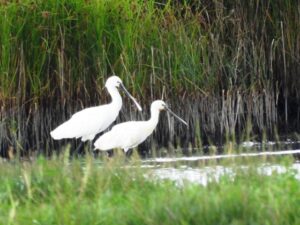

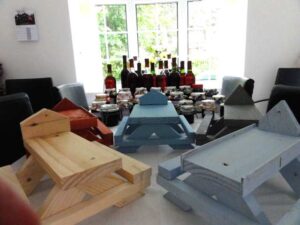


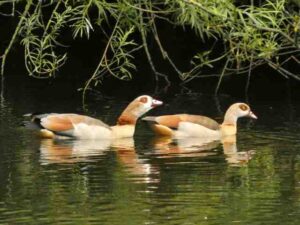
Last Monday I ventured out to Hilbre for the first time this year. As I left West Kirby, the sky looked threatening but the weather soon improved and I enjoyed my time there over the high tide. There were 2 families staying in the houses there, otherwise I had the island to myself. Oh, apart from the birds and grey seals of course!
A pair of Cormorants had settled on the north end, until the rising tide flushed them off. At the south end, a mix of Sanderling, Dunlin and Ringed Plover roosted over the high tide. The Sanderling were mid-moult sporting a mix of grey and reddish feathers, quite different from the pale, full winter plumage we are more used to. The Dunlin were mostly black-bellied still too. One photo below shows a group of browner Dunlin with a single, greyer Sanderling amongst them – can you pick it out?
On the beach at Hoylake a group of Starlings was busy feeding. I am not sure what they were finding, maybe sand flies, but every time they were flushed by passers-by they kept returning. Amongst the flock were young birds with a mix of juvenile brown feathers and black adult feathers – making them look slightly odd but also quite stunning, I think.
At Burton Mere Wetlands, a pair of Egyptian Geese took up residency over the summer, but they do not appear to have bred. They were busy eating the water-lily flowers on the Mere however! These introduced birds can elicit a bit of a Marmite reaction amongst birders but they do look quite pretty close-up.
Bill took a photo of 2 of the Spoonbill that are frequenting the flashes at Parkgate. Up to 8 birds have been seen over the last week!
Brian Bishop has been busy during lockdown building some impressive bird tables. He assures me that the wine is for him, not the birds – a better choice than stockpiling toilet rolls!
Hugh Stewart







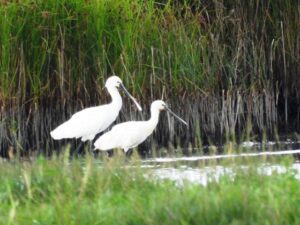

It is great news that we have found a new and exciting location for our Indoor meetings. It will be sad to part with Kingsmead after so many years but we are sure you will like the new premises at St. Bridget’s Centre.
Continuing on from Barry’s Badger saga, he has sent me a photo of him making friends with a Pelican on an overseas holiday. Pam assures me that this photo is genuine, albeit from a few years ago! I think this is a White Pelican, the slightly more common of the two species found in Europe, mostly around the eastern Mediterranean. But it is still quite scarce, even there. The other species is the even rarer Dalmatian Pelican. Also attached is a picture of two White Pelicans that Barry took on a trip to the Danube Delta a while back.
Barry had a small flock of young Long-tailed Tits on the fat-balls in his garden. Long-tailed Tits are very charismatic anyway, but I think the fluffy juveniles are even more cute. You can see large flocks of these birds at this time of year consisting of combined family groups, foraging for food while enjoying safety in numbers from predators.
I woke up recently and saw a bird of prey on the neighbour’s garden trellis. From the size and colour it looked like a Peregrine Falcon, not a bird that normally frequents gardens. Sparrowhawks however will often perch in and around gardens, especially close to bird feeders looking for their next meal. I eventually woke up properly and checked through my binoculars, and saw that it was indeed a Peregrine – but an ornamental one! Even now I know it is there, it still sometimes gets me going for a split second when I see it out of the corner of my eye!
Hugh Stewart



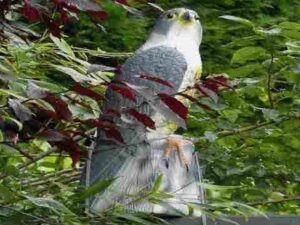
We are slowly being allowed out more, although we are still not out of the woods yet. You have hopefully been able to get your hair cut at least – I am booked in next week!
Now that Wales has opened up its borders, I had a walk around Glyndyfrdwy near Llangollen last week. This venue was on our programme for a visit this spring, but sadly had to be cancelled. The birds were much harder to spot now, but I still enjoyed the walk up the valley and the views across the open moorland. A family party of 3 Crossbills was the highlight. We will re-arrange a visit here soon, I am sure.
Bill made a trip to South Stack on Anglesey to enjoy the mass activity on the cliffs. There are still plenty of birds there, but it will not be long before they start to disperse out to sea. Birds seen included Choughs, Guillemots, Fulmars, Gannets, Kittiwakes and Puffins. Then he went to Cemlyn Bay to see the Tern colonies (Arctic and Sandwich).
Joyce thought she saw a female Blackcap in her garden this week. This is quite possible, as “our” birds will have largely finished nesting and will be searching earnestly for food in order to build up their fat reserves in preparation for the long migration to Africa for the winter. The Blackcaps we see here in the winter on our bird tables are different birds – they come from central European countries such as Germany to escape the harsher weather there.
Now a confession! The photo of the badger in Barry’s garden in the last edition was a set-up! In fact, the head was given to him, and he had just placed it in the garden for the photo. It certainly fooled me! His photos of a pair of Collared Doves and of two juvenile Starlings are genuine – honest! Young Starlings in their brown plumage often confuse people who are expecting black-looking birds.
Hugh Stewart







I know that one or two of you are aware of the presence of Quails on Wirral this year. Quails are small game birds that are migratory, spending the winter in southern Europe and Africa. They are most common in the south and east of England, and we occasionally have a few birds passing through in the Spring, especially on the Dee marshes, but they usually soon move on A few birds reportedly breed in Cheshire and Wirral, but that is quite rare.
However this year – probably because of the long settled spell of weather in April and May – there was quite an influx locally, with birds reported calling at Parkgate and Denhall (and maybe other sites). There has also been two (male) birds heard, and very occasionally individuals seen briefly, in the field by the RAF Monument on Saughall Massie Road. Quail can be incredibly hard to see, even when they are very close; but their distinctive “wet my lips” calls carry a long way. Be aware however that they are great ventriloquists – you think the calls are coming from one spot, only for a bird to appear from a totally different direction! If you are lucky, you can get a glimpse when they fly low across the crop. As the Saughall Massie birds are still there now, there is a good chance of breeding.
Meanwhile, back in Barry’s garden! Attached is a photo of a non-avian visitor he saw the other day. Peering out of the flower bed was a badger! Would you believe it?! He also reports that he has seen fledglings from 12 different species and lots of them, including a Great-spotted Woodpecker. Can anyone beat that? He sees 23 species on average per week and 41 in total all since March 15th. Yet he has not seen a single House Martin and only rarely a Swift or Swallow. Birds can be fickle (Also, you cannot tempt them to garden feeders!).
Bill sent in a couple of pictures of birds he saw near Burton Point – a Sedge Warbler and a Meadow Pipit.
It is amazing what you sometimes discover on the web. In Yemen last year, a migrating Griffon Vulture fitted with a GPS transmitter, helping researchers in Bulgaria understand its movements, was captured having been mistaken for a ‘spy’ by militants in the ongoing conflict in Yemen. Luckily the Yemenis were persuaded that vulture was not there to spy on them and he was released.
Sadly the detention of this Griffon Vulture is not the first example of the misunderstandings over animal tags in conflict areas. There are countless examples of migratory birds fitted with tags being victims of the tensions between conflicting forces in the Middle East. two years ago another Griffon Vulture was detained in Lebanon, which was subsequently returned to Israel. White storks with tags have also been “detained” in Egypt. Migration can be hazardous enough, without being detained for spying!
Hugh Stewart

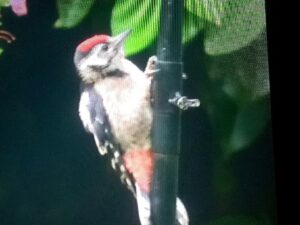


Step by step, the country is slowly coming out of lockdown. We will all take on the permitted changes at our own pace. I am certainly in no rush to go to MacDonald’s or Cheshire Oaks!
As Joyce refers to, in the meantime we can continue with our local walks and enjoy our gardens if you have one. A recent study by Natural England found that 87% of people when asked, agreed with the statement “Being in nature makes me very happy”, with nearly half agreeing strongly. I hope that your involvement with Wirral Bird Club is helping you in a small way through these strange times.
One piece of positive news this week is that Burton Mere Wetlands reserve has re-opened, albeit with restrictions on car parking spaces (in order to limit visitor numbers); and the Visitors’ Centre and hides remain closed. So you may wish to delay your visit for a little while.
Continuing the theme from last time of the new generation of birds, I came across a group of four young Swallows being fed by their busy parents. As the adults returned to the brood, they passed the food into the begging mouths before in a flash speeding off again to catch more prey on the wing. It must have been hard work, but it appeared to be successful. In the same area, a Sedge Warbler, with its distinctive white stripe (or supercilium, to give it its proper name) above the eye, was still belting out its excited song. A male Reed Bunting perched nicely for me too, but didn’t produce his short, simple song.
Barry has seen 3 partially leucistic Blackbirds in his garden. This phenomenon occurs when the feathers lack the normal black melanin pigmentation, and is not that rare in several bird species such as Blackbirds, corvids and House Sparrows for example. Leucism is different from true albinism, which is much rarer. Many of you may have seen birds similarly affected. What I was unaware of though, until I researched for this article, was that the leucistic trait may be partially hereditary, which may explain the number of examples in Barry’s garden. You see, I am still learning about birds, I don’t know everything!
A member of the public sent us a photo of a Jay feather that she had come across. The vivid blue stands out so markedly, it could really only be from a Jay. It is a pity these are normally such shy birds!
Talk again soon. Stay safe.
Hugh Stewart






The long spell of settled weather had to end eventually, and things have certainly changed over the last few days! I am sure the gardeners will welcome the drenching though. Temperatures are still reasonable, albeit several degrees lower than it has been on most days recently.
As long as the rain does not continue for too long, hopefully birds will not suffer too much. The birds most at risk potentially will be newly fledged youngsters, which can succumb to longer periods of cold and rain.
I know several of you have seen plenty of evidence of a successful breeding season, and we have had some brilliant photos sent in to demonstrate this.
Bill captured a male Great-spotted Woodpecker (with red on the nape) feeding a youngster (identified by the full red cap) in their nest hole in Irby. He also snapped a pair of young Peregrine Falcons on a water tower.
Barry has sent in a baby Robin having a bath, and a Blue Tit with a fluffy baby. Barry also sent in this wonderful picture of a Green Woodpecker – not in his own garden this time but his daughter’s. He was understandably “chough-ed” (Sorry folks!).
In my own garden, I have seen at least one young Robin but not managed to capture it. They were much more wary than its parents. I did though snap one of the two Blackbird fledglings being fed by Dad. I have not seen the female Blackbird for a few days now, so I am wondering if she is looking after separate chicks in a nearby garden, sharing the parental duties. Or has she been taken by a cat or Sparrowhawk? I hope not!
Provided the weather improves, some of these birds will start another brood, as there is plenty of time to do so. Keep looking!
I will take this opportunity to remind you what to do if you find a baby bird, although many of you are aware already. In most instances, the parents will be close by and be aware of the chick. The best chance of survival is if the chick continues to be fed by the parents. So unless the chick looks sick or injured, leave it where it is, or put it higher up on a branch etc., if it is at risk on the ground. The parent will find it.
A sick or injured bird may need intervention as a last resort. Put the bird in a box to keep it quiet. Phone the RSPCA (Tel 0300 1234 999) or a friendly, local vet for advice. As the animal services are inundated with calls about baby birds at this time of year, be aware that they may be limited in what they can do.
With that, I will just wish you an eggcellent weekend!
Hugh Stewart







I have taken the opportunity of sifting through loads of old bird magazines that have been sitting in in the loft! I used to refer to them periodically for information on birds and bird sites, but confess that they have just been gathering dust recently. Flicking through them again now, it is interesting to see what was in the articles in past years.
Do you remember when Foot and Mouth Disease devastated the UK in February 2001? Like now, we were severely restricted from visiting the countryside for several months and many farm animals were sadly slaughtered – although fortunately there was not the same risk to human life as there is with Covid-19. Frustrating though it was at the time, we coped then, and we will hopefully cope again now.
The status of some birds on Wirral has certainly changed in the last 20 or 30 years. I still remember “twitching” a Little Egret at Parkgate not long after I moved to Wirral in 1990! Back then they had started to frequent the South of England in summer but had still not bred in the UK. Now they are so common that we almost take them for granted on a walk long the Dee. As for Great Egret, Cattle Egret and Spoonbill, these were still “mega” rarities! These species are now slowly colonising England too. It will be interesting to find out what has been breeding this year, once we can visit out-of-bounds sites again. Watch this space!
Conversely, the odd Pied Flycatcher, Lesser Spotted Woodpecker and Wood Warbler were still nesting in locations such as Stapledon Woods and Eastham Woods, but sadly they have long ceased to breed on Wirral.
Blackcaps are now regular winter visitors to gardens, involving birds from central Europe rather than UK breeding birds which migrate south. This is a relatively new adaptation however, an interesting change in behaviour that may be linked to our milder winters in recent years.
Some things do not change however. The sad persecution of birds of prey has been prevalent for years especially of raptors on moor land, and does not show signs of diminishing. Red Kites were down to just a handful of breeding females in mid-Wales in the 1980s. Through a combination of reinforced protection (including the protection of nests by the SAS!) and latterly several re-introduction schemes, their numbers have increased significantly. Birds are being reported more and more frequently over Wirral which is wonderful. This magnificent bird is still at risk from shooting or poisoning in some areas though, notably Black Isle in Scotland.
The photos of the Little Egret and male Pied Flycatcher are mine. The other images are all from Barry’s garden again. Doesn’t he do well for wildlife! They feature a Goldfinch feeding a fledgling; Carrion Crow; Harry the hedgehog; and my favourite which is a frog in his pond. OK, a couple aren’t birds but it is all part of life’s rich pageantry.
That’s all for now folks!
Hugh Stewart
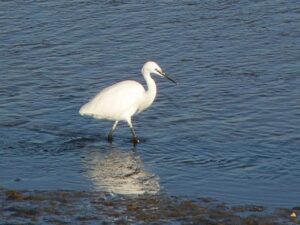
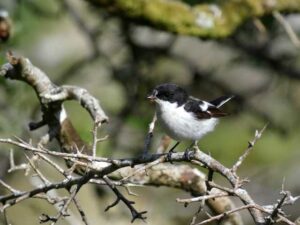
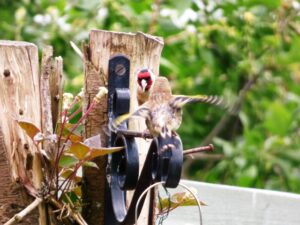


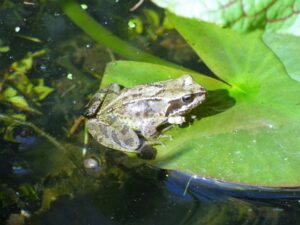
For this latest issue, we have a report kindly sent in by Andy and Jo Morton of a trip to New Zealand earlier in the year.
“We have recently returned from holiday in the north island of New Zealand and would like to share our experiences of some of the birdlife there. We didn’t go equipped for bird watching or filming, but were observant of what was around us.
We spent most of our time in coastal areas (Auckland, Bay of Islands, Napier, Wellington), and common to all of these were the three resident gull species (black billed gull, red billed gull and black backed gull) and variable oystercatcher. In the Bay of Islands we travelled out into the bay where we saw tākapu (Australasian gannet) diving for fish, spotted shag, black shag, and white fronted tern, with great shearwater tipping their long wings into the water further out to sea. Elsewhere on the water we saw a white faced heron and black swans.
South of the Bay of Islands near Whangarei, we drove around the windy coastal roads where we came across pukeko (Australasian swamphen), quail and wild turkey by the side of (and sometimes in the middle of) the road.
Inland around Hamilton and Rotorua, we saw a number of native species – tui, welcome swallow, common myna, North Island robin and Australian magpie. Almost everywhere we went there were familiar species that had been introduced into New Zealand by European settlers – house sparrow, blackbird, song thrush and mallard. Out in the open countryside was the common sight of the swamp harrier circling for prey.
In Rotorua, there is a conservation project to protect the brown kiwi and we were lucky enough to see one in the dark.
Finally, in Wellington there is a large conservation area called Zealandia, with forest and lake habitat, and we were able to see tui, takahē, tieke (saddleback), kaka, kereru (New Zealand pigeon), fantail, koirimako (bellbird), little shag and brown teal. Tui have a noisy, unusual call that combines bellbird-like notes with clicks, cackles, timber-like creaks and groans, and wheezing sounds. They also copy other sounds (even the famous Nokia ringtone). Takahē is an endangered species that is being bred at Zealandia (and it even appears in the Air New Zealand in-flight safety video – see https://www.youtube.com/user/airnewzealand), as is the kaka, a large noisy parrot.
Back in 2012 we visited the south island, where we saw albatrosses and petrels whilst whale watching off Kaikoura, and also little blue penguin and yellow eyed penguin on the Otago peninsula.”
Andy & Jo Morton
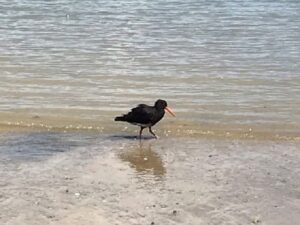



I hope you will indulge me in this latest Hugh’s News, as it is very much about me! And some birds, of course.
I am sure that everyone lucky enough to have a garden has spent a significant amount of time in them during lockdown, gardening and enjoying the sunshine. I have certainly spent more time out the back than I would normally.
As soon as I started digging the beds, a pair of Robins started following me looking for insects. From feeding them through the winter and spring I know they were nesting in next door’s garden and were feeding chicks. As the days passed, they became more bold in my presence, getting ever closer to me. So I thought I would try tempting them with a little raw minced beef, on top of the usual daily supply of sunflower hearts and rolled oats.
They were soon coming to feed even when I was still close to the feeding area, allowing me to get some nice photos. One of the Robins appears to have ruffled feathers on the belly which I think is the brood patch on the female. The other bird which I assume is the male is more pristine still. I have just briefly seen a young Robin on the fence, so at least one youngster has successfully fledged.
Soon a pair of Blackbirds cottoned on to what was happening and started muscling in on the beef! They nearly always took all the meat away in their bills in one visit, leaving the Robins looking rather forlorn!
I now need to buy more mince on my next weekly shop, but I think it is a price worth paying for the enjoyment of these intimate encounters with my garden birds.
Hugh Stewart






It is a little over a week since the last issue, and a week closer to starting to loosen the lockdown shackles!
After I confessed last time to not obtaining a photo of a Whitethroat from Heswall Fields, Peter and Jane Ham kindly sent in a cracking image of one that Peter snapped. It is better than anything I would manage!
Barry has sent a few more photos in of birds in his garden. He has an amazing variety visiting, but it must cost a small fortune in feed! I wonder if the House Sparrow here is the same one that flew into his house last week? Barry mentioned that the Black-backed Gull he saw appeared particularly dark on the back. This was probably a dark intermedius sub-species on its way to Scandinavia. Our local breeding birds of the graellsii race tend to be a little lighter grey comparatively (but still a noticeably darker grey than a Herring Gull). The whole Lesser-black Back/Herring Gull complex is however very complicated – even for Larid fans, let alone me!
We received a follow-up email from Martyn Jamieson informing us that one of the black-tailed godwits in ‘his’ South Uist creek was colour-ringed, so he got the ‘scope on it and sent details and a photo in to the experts. He has now had a report back showing its history of sightings. The bird is 15 years old and quite a well-travelled bird, visiting Iceland, Ireland, The Netherlands, Portugal and finally Scotland over the years since it was first ringed!
Walking the same route regularly under lockdown means it soon becomes hard to find new bird species. Instead, I found myself noting other interesting natural sights. I think the gorse is at its best now, and the odour emanating from the bright yellow blooms reminds me of coconut and suntan lotion! Oh to be able to go on holiday now! Tadpoles were swimming on the surface of the pool in Heswall Fields – at least when there were no dogs paddling in it. With the warm weather, butterflies are plentiful with Speckled Woods seen in shady glades.
After the showers last week, did you notice the particular smell that occurs when it rains after a dry spell? This characteristic smell is known as “petrichor” – I’ve been looking for an opportunity to use this word since I learnt it a couple of years ago!
There has been the odd new bird as well of course, and I have added House Martin to my lockdown list recently, and this morning 5 Swifts over Heswall. That has made my day!
Until the next time, keep smiling!
Hugh Stewart

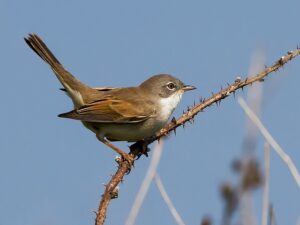





So we are nearly at the end of April, and some birds already have young. I briefly saw a fledged Robin from a nest in our neighbour’s garden. Other species are still to start laying, especially the summer migrants that are only just arriving. Other species are yet to complete their journeys here, like Spotted Flycatchers and Swifts. So you can see that the migration and nesting periods can be spread over several weeks, even months. Blackbirds and Robins (amongst other species) may have two or even more broods in a year if the conditions are favourable in terms of weather and food availability.
Barry took his home birding a bit too literally when a cock House Sparrow came into their house for a look around! After it had decided that Pam keeps a very tidy house and that there were no titbits to be found, he left again.
Bill captured a colourful Jay in Arrowe Park. Normally I think of Jays as being secretive for most of the year, only becoming more conspicuous in the autumn when they are busy collecting and caching acorns to feed on over the winter. How do they remember where they hid them all?! I have noticed however that they have been a bit more evident on my walks over the last two or three weeks. I’ve not managed to snap one though – they are quite wary birds normally. Bill also found the “rarity of the week” with a Tree Pipit. The 2004-2007 atlas of Birds in Cheshire and Wirral shows no records of breeding Tree Pipits in Wirral, so this was probably a migrant bird stopping off to refuel.
You can tell my birding has gone a bit flat when I have to resort to taking photos of Pheasants! But a male bird with his mate on the marsh at Parkgate did look colourful in the early morning sunshine. A Wren was belting out its loud and varied song from a branch beside the Wirral Way, at a rate of up to 8 notes per second! Nearby a Chiffchaff was enjoying a brief rest before resuming its busy feeding and calling pattern. I did see my first Whitethroat of the year today though – sorry no photo!
It looks like the glorious weather we have enjoyed throughout April may be ending this week, but we cannot complain too much really. Think what it could have been like if we had had to endure persistent rain and grey skies for the whole of lockdown. The gardeners at least will be grateful for the watering, I am sure. We may just have to pick the times for our walks a little more carefully in order to avoid the showers.
So until the next time, take care as always and stay safe.
Hugh Stewart






Well, it came as no surprise to me that we have another 3 weeks of isolation at least! I hope you are not going too stir crazy stuck at home. I have actually found that the last month has gone quite quickly (surprisingly), I think by keeping busy on various tasks and activities, so I hope the next month passes just as rapidly.
Since my last instalment, I have seen my first pair of Swallows, so summer has officially arrived! On Wednesday I also saw a single House Martin down Boathouse Lane. I always smile and feel good when these birds return to breed, and marvel at the huge return journeys they make every year. Wheatears are still passing through, and I have seen a couple of male birds on my walks. They can turn up on any field with short grass or that has been recently ploughed, so keep an eye out.
We have received a number of contributions from members, so a big thank you for sending these in to share.
Long-standing members may remember Martyn Jamieson, one of our Honorary Members now living in the Outer Hebrides. As well as being situated in such a beautiful place, he is also fortunate that there have been no Covid-19 cases reported there so far!
Martyn has sent us an update on what he has been seeing from his croft with photographs. These include a pair of White-tailed Eagles he saw from his window! The adult eagle (on the right, big, probably a female) had caught a greylag, and the immature came along hoping to share. This was a bit smaller, so probably male. The hooded crow between the two eagles really gives an idea of the scale of these huge raptors. They are not known as “flying barn doors” for nothing! A week or so previously he encountered a very noisy otter, that called incessantly for hours. Martyn thinks it was probably a cub recently abandoned by Mum. At one point it chased a couple of greylags just for devilment, just like a puppy. Unlike the English otters that favour rivers and are largely nocturnal, the otters in Scotland tend to be coastal and their feeding more governed by the state of the tides. So they can frequently be seen during the day. Are you a teeny bit jealous of Martyn now?!
Bill has shared some photos too. A Starling posing in the sunshine in his neighbour’s garden looks really magnificent. We often don’t take a second look at this species but the markings can be stunning. On his local walk down to Arrowe Park, Bill saw a Heron and a two-headed Mandarin Duck!
How did you get on with the Find the Bird photo from Brian last time? It is easier to pick out if you were able to zoom in on the photo. There is in fact a Treecreeper creeping in the crevice!
There is growing evidence to show that taking an interest in birds, and nature in general, can be really positive for one’s mental health. So during these troubled times, we should consider ourselves fortunate that we can still benefit from our mutual love of birds, even from looking out from our windows and gardens.
So keep the binoculars handy, keep smiling and keep safe!
Hugh Stewart






Thank you for the comments and photos that I have received over the last few days. As well as being interesting to learn of your experiences, it also means I don’t have to think so much on what to write about!
I saw a pair of Buzzards high over – almost certainly a pair close to their nest site. Later in the year after breeding, you can often see family groups of at least 4 or 5 Buzzards circling in the thermals. This is a more and more common sight on Wirral – when I came here only 30 odd years ago, one had to go to Wales to see a Buzzard.
Bill Wonderley was sent a photo from a member of the public who saw a Wheatear on their daily walk and wondered if it was a Greenland Wheatear. This is a sub-species of the Northern Wheatear that breeds in the UK, but which goes as far as Greenland and Canada to breed. I could not tell the subtle differences between the races from the photo but the Greenland Wheatear normally migrate later in the spring than just now so I doubt it was one.
I had a call from a non-member who told me that she has had a pair of mandarins turn up on her Spital pond! They will be looking for a tree hole to nest in, or a nest box with a large hole! This is not a joke – I know that they do use purpose-made nest-boxes.
On my own walks, I have been cheered by the songs of many species now on territory. This includes not only the regular garden Robin and Blackbird, but also several Song Thrushes that remain so elusive for much of the year. Chiffchaffs are seemingly everywhere there are some trees, and I have seen and heard one Blackcap.
I am pleased to see far more Greenfinches than for a long time, further evidence to me that they are making a recovery after their numbers fell due for several years to a fungal disease. They are quite noticeable in their fluttering song-flight. As a reminder that some of our winter visitors are also on the move, I saw a small mixed flock of Redwing and Fieldfare. It is impossible to know if they had spent the winter locally or were returning from further south or west, even from Ireland. Either way, they will soon depart our shores for Iceland and Scandinavia.
For this article’s photos shown below, the first is of a Wren that Bill saw in a local brook. This is an unusual sight – maybe it thought it was a Dipper! Also attached are pictures of Greenfinch and Song Thrush, two of the songsters I have mentioned.
Lastly, Brian Bishop has kindly sent a “Find the Bird” competition. No prizes, just a bit of fun! I will share the answer next time.
On a final note, best wishes to you all for Easter. I have decided to relocate for a change of scenery over the holiday weekend – I am going to try the view from the other end of the sofa! Happy, safe birding.
Hugh Stewart
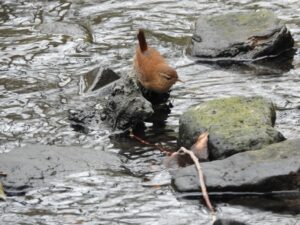
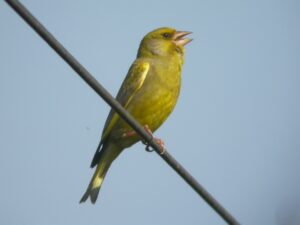

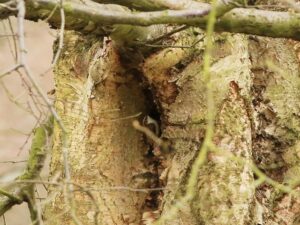
Yesterday was of course due to be the March indoor meeting. It was a difficult decision to suspend our programme, but really it became inevitable as the scale of the pandemic threat increased. Hopefully we can all get through the coming weeks without too much turmoil and then begin to resume a more normal life again.
In the meantime, due to social distancing I should have more time to update members regularly on this blog. No excuses! I hope you particularly like the articles at this time of isolation.
Of course, we are just beginning to enter the main spring migration period, always an exciting time of year after the long winter. It is just a pity that the opportunities to get out to witness it are limited this year. Before the more strict lock-down instructions were issued, I know that Avocet numbers were increasing daily at their main breeding site at Burton Mere Wetlands, with over 100 birds seen. Wheatears are beginning to trickle in on the coast and Hilbre, and numbers will swell over the next 2 or 3 weeks. Chiffchaffs have been seen and heard singing. These are the usual early migrants but the number of species coming through will build now, especially with good weather.
I am already looking forward to seeing the first Swallow and Sand Martin of the year over my garden, always a inspiring moment that tells you that summer has arrived. A little later, screaming Swifts will be wheeling overhead. A single Spoonbill dropped into Burton Mere Wetlands on Tuesday 17th March before relocating to Parkgate. Two birds were then reported on the 25th! Could they become a breeding pair? Time will tell.
I have decided to include a few photos from previous Field Meetings to make up for this week’s cancelled visit to Heswall. These are from 2015 and 2016! I hope you enjoy them.
If you have any observations from your gardens or your exercise walks, please let me know and I will share them with members.
Send to [email protected].
In the meantime, stay safe. I will post again soon hopefully.
Hugh Stewart
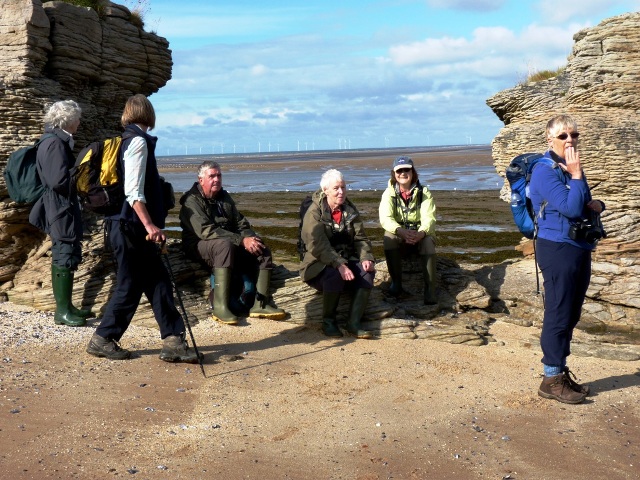
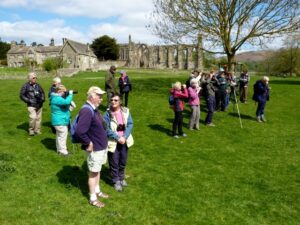
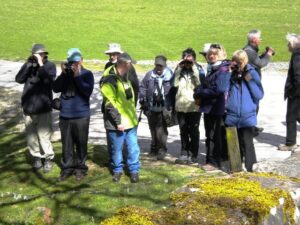
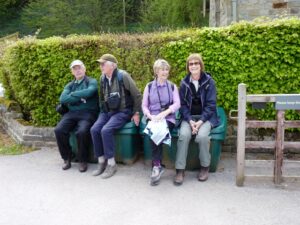
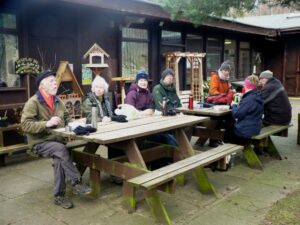
This winter continues to be particularly mild to me, with just a handful of mornings when I have had to scrape the frost off my car windscreen. Has that been your impression too? Even the Welsh hills across the Dee have only had a dusting of snow on the odd occasion that I have noted.
The results for my Big Garden Birdwatch in January were pathetic! The variety and numbers of birds that I recorded in the allotted hour were the lowest I have seen for many a year. I am sure this was related to the especially clement weather we had at the time. The lack of birds does not necessarily reflect a fall in bird populations, but rather indicates there was lots of natural food for the birds around the locality and so they were less reliant on “food bank” hand-outs! How did your count go?
However, while we have escaped the severe cold, we have certainly made up for the lack of snow with plenty of wind and rain! At least the ducks and geese like it! Storm Ciara gave Wirral a true battering, and Storm Dennis is about to sweep across as I write. The wind chill factor was noticeable at times, but even these events do not last long.
I have spring bulbs blossoming and various buds showing well in the garden, as I am sure you have. The lawn has barely stopped growing. So while we may yet get a sting in the tale, it looks like spring may be just around the corner. I hope I haven’t spoken too soon!
A promising sign is that the first Avocet returned to Burton Mere Wetlands on Thursday 13th February – last year it was just a day later on 14th February. This species is always one of the first of our summer migrants to return, and the especially early re-appearances may well indicate that the Dee birds winter in the UK rather than on the continent. Soon, we should have Wheatear and Sand Martin passing through, then we can really welcome in spring and the flood of other summer visitors. Bring it on!
Hugh Stewart
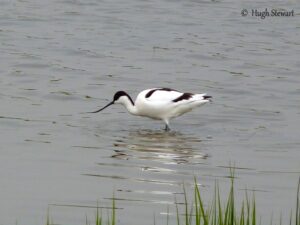
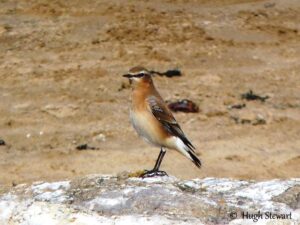
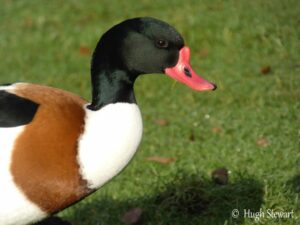
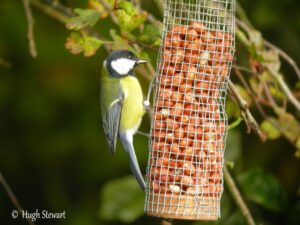
I am aware that we have a few new members that have joined the Club recently. Welcome to everyone to the new Programme for 2019 – 2020, and to this article. Hugh’s News is an occasional piece posted on the Club’s website with random thoughts on (mostly) bird related topics that I hope you will enjoy. While my name is used on the header, we welcome any comments or ideas from Members. Similarly, contributions for the Newsletter that is published 3 times per year are gratefully received.
On a recent walk at Leasowe Common, I found two small rodents in the grass right by the side of the path. After some research on-line back home, I decided that they were young Field Voles. The small ears, roundish face and relatively short tail differentiated them from mice. They were fairly exposed, and were not moving around much. There was no sign of a parent, but maybe they were close by waiting for me to move away, so I decided to leave them be. Hopefully they survived. Of course, they are potential food items for a number of birds, as well as stoats or weasels, so the outlook was not too good if they didn’t learn some field craft quickly.
I went to the Parkgate Old Baths car park today for the high tide. In stark contrast to the inclement weather we experienced on Saturday’s field meeting at Meols, the morning was sunny and mild with very little wind. With these benign conditions, the tide did not come in that far, but there was still a good variety of birds on show. At least 3 Marsh Harriers were almost constantly patrolling the marsh. Several Great Egrets were also evident, as was a single Cattle Egret – unusual this far down the river – along with the ubiquitous Little Egrets. A Spoonbill made a brief appearance before disappearing into a creek never to be seen again! Sight of the day was a Peregrine determinedly chasing a Merlin in front of us. I don’t think the larger raptor was looking to catch the smaller one, probably just annoyed that it was on its “patch”. A few Pink-footed Geese are already on the Dee for the winter, but the numbers will build over the next few weeks, as will wader flocks. A few tardy Swallows passed through on their way to Southern Africa, perhaps one of the last images of the summer gone. If you missed these high tides, there will be more at the end of October. I will aim to provide more details nearer the time – remind me if I forget!
Hugh Stewart
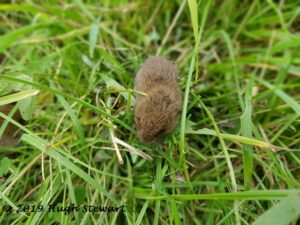
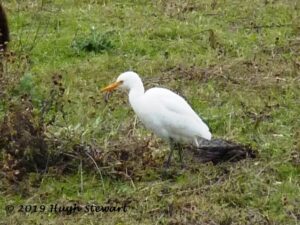
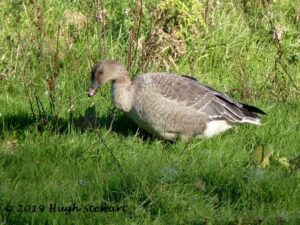
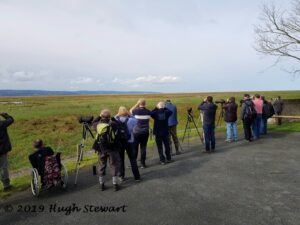
The consensus is that the mystery chat we saw at Gronant on the July field trip was a juvenile Stonechat. This species breeds in the area and so was always the more likely, but it was not an easy bird to nail down (not literally!).
Rare bird of last month was a Gull-billed Tern that stayed for a few days near Thurstaston. Blaze and I visited a couple of times but missed out on both occasions because the state of the tide was not right – either too high or too low! We have reached 45 species for the year now, but are still debating whether to tick the Guineafowl under the bird feeders at Nets Cafe!
This year the UK is experiencing a massive influx of Painted Lady butterflies from southern Europe. These are annual migrants to our shores, but once every decade or so they arrive in their millions in May and June, with numbers augmented now by breeding from the early arrivals. I have had 10 – 12 on my Buddleia this week when the sun is out, along with more regular Peacock, Small Tortoiseshell, Red Admiral and Large White.
This year’s Wirral Wader Festival will be hosted entirely at Burton Mere Wetlands, a decision based on tides, weather, and RSPB Dee Estuary’s 40th anniversary. The dates of the event are Saturday 31 August and Sunday 1 September. There will be a range of stalls and activities including making badges and pom-pom waders, a ‘creatures in the mud’ activity, and hide bird guides. There will be also a full optics demo event if you are thinking about buying new binoculars or a telescope. Drinks and cakes will be available if you need refreshments.
I hope you enjoyed my talk on Bardsey if you attended. That was the last meeting on the current programme as we take a break for the summer. However, you don’t have to suffer withdrawal symptoms for long – we start again with a visit to Hilbre over the high tide on Friday 30th August. Look out for more details from Mike a few days before the trip.
Hugh Stewart
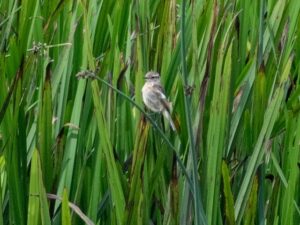
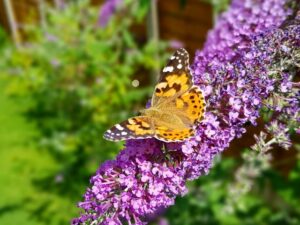
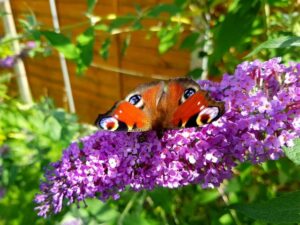
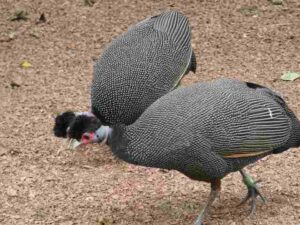
Big Garden Birdwatch Results
We can now reveal 2019’s Garden Birdwatch results. Once again, the house sparrow has hit the top spot. At number two is the starling, closely followed by the blue tit and the blackbird. The woodpigeon flies in at number five, followed by the goldfinch, great tit, and robin at number 8. The top eight remain the same as last year, so it’s a battle for numbers nine and 10. The chaffinch has seen off the long-tailed tit to be at number 9, and the magpie has crept in at number 10.
These are the national figures, but of course there will be variation across the country and even from garden to garden in the same region. How did you fare?
Great Egret Successfully Released
The RSPCA had to carry out a water rescue after a Great Egret became entangled in fishing line at Thornycroft Hall near Macclesfield, Cheshire. The bird was unable to free itself at the site and concerned anglers contacted the animal welfare charity after spotting the distressed egret. Despite some injuries, the bird is doing well and has now been released back into the wild at Burton Mere Wetlands RSPB reserve following a full recovery. Nice to hear a story with a happy ending.
Birding Cur-tailed!
I have some news from the home front. We have just bought a Border Collie puppy which will certainly curtail my birding, in the short-term at least! So I have decided to start a new bird list, to add to my current British, European and World lists. “Birds seen while walking the dog”! Until Blaze has completed his vaccinations, we are restricted to the garden, so we are missing out on lots of passing migrants. However, we already have Willow Warbler, Chiffchaff and a fly-over Raven ticked, as well as a few common garden birds. I will post occasional updates on our progress!
Hugh Stewart
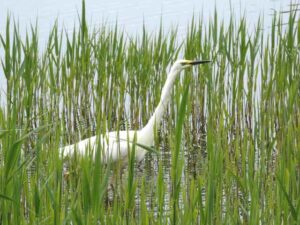
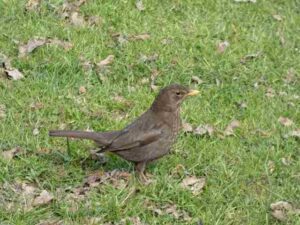
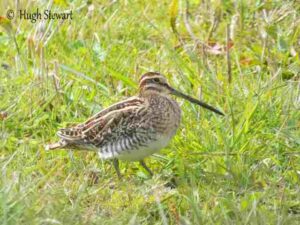

While I have been away on holiday, I missed the unseasonable warm weather that the UK experienced. I say “unseasonal” but in fact I can remember 2 or 3 short periods of hot weather in February or March over recent years. Are they connected with global warming – who knows? Certainly it is a big contrast to the long, cold spring of 2018. A consequence of this recent heatwave and associated favourable winds was the early appearance of several migrants on Wirral.
The first Avocet was back at Burton Mere Wetlands RSPB on 14th February, with at least 50 birds by 27th of the month. They are now showing signs of starting to nest as I write this article in the first week of March. At Fort Perch, New Brighton, a Sand Martin on February 16th was the earliest ever for Cheshire and Wirral. The first Wheatear of spring on 27th February at Hoylake Langfields was 11 days earlier than last year. A day later, a White Wagtail in the horse paddocks at Leasowe was 15 days earlier than last year.
If you have missed these first summer visitors, do not worry as there will be many more arriving over the next month or two. Join us on the next couple of Field Meetings at Leasowe and Blacktoft Sands RSPB for a good chance of seeing them.
Of course, a sudden deterioration in the weather to cold or wet conditions could hold migration and breeding back, but birds are pretty resilient and will generally cope with this change as long as it does not last too long.
There are still plenty of winter visitors on the Dee though. There is another Raptor Watch this Sunday 10th March from 1pm until dusk at Parkgate Old Baths Car Park. And High Tide Birdwatches on Thursday 21st March, Friday 22nd March and Saturday 23rd March from 10.30am-2.30pm, also at Parkgate. The RSPB will be on hand to help point out the birds.
As for my holiday, you will have to wait until 2020 for my talk about it. But I have provided a small clue below!
Hugh Stewart
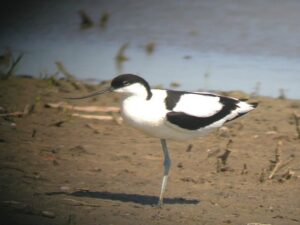
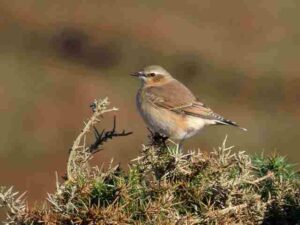
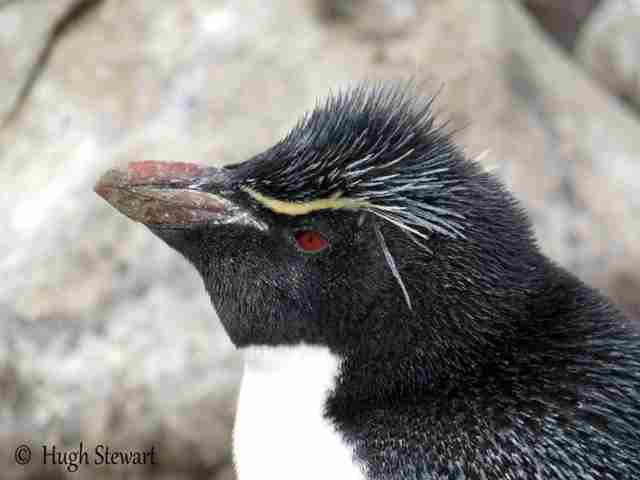
A happy New Year to you all, I hope you enjoyed the festive season and are already well into your 2019 Bird List!
January High Tides
As you know, we were forced to cancel December’s field trip to the Dee due to the inclement weather. However, there are some good opportunities coming up to make a visit to see the spectacular birds currently on the marshes. There are a number of predicted high tides over the next week which, with the right weather conditions (low pressure in the Irish Sea and westerly winds), may bring the water up to the wall at Parkgate. Even if the water does not totally flood the marshes, there should still be some good views of Marsh and Hen harriers, Peregrine, Merlin, Short-eared Owls, and possibly Bittern. Noisy skeins of Pink-footed Geese should also be seen flying overhead.
The best dates, tide heights and times should be [but check the weather forecasts too]:
Tuesday 22nd January, 9.9m at 11:48.
Wednesday 23rd January, 10.0m at 12:36.
Thursday 24th January, 9.9m at 13:23.
It is recommended that you are there an hour or so before the high tide time, to get a good spot and experience the developing drama. The RSPB will be at Parkgate Old Baths on Wednesday 23rd January to help point out the wildlife as it shows itself. I hope to be there too!
But don’t worry if you don’t make it, there will be more spring tides in February and March, including a possible 10.2m tide on 21st February at 12:20!
Not coinciding with a high tide specifically, but there will also be a Raptorwatch at Parkgate Old Baths organised by the RSPB, between 1pm and dusk on Sunday 10th February, where many of the same species may be seen.
You can just turn up to any of these events.
Bearded Tits
Well, after 3 visits and over 3 hours in total staring into the reed bed from the screen, I finally saw the famed Bearded Tits at Burton Mere Wetlands! Hurrah! There were 4 birds in total, a little way off at the far end of a channel in the reeds that they seem to favour, but eventually they perched in good view as they fed on the seed heads. They were too distant to get a photograph unfortunately, but I have finally “ticked them”! I know some other members have seen them already too, and not all had to spend quite so long looking! But my patience was rewarded in the end, they are such exquisite and charming birds.
If you haven’t managed to see them yet, there is another chance of getting views on our forthcoming coach trip to Blacktoft Sands on 14th April!
Hugh Stewart


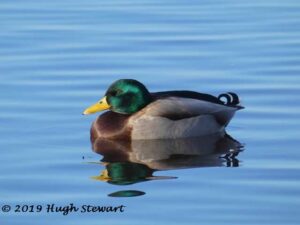

As we pass slowly into winter, it is perhaps a good time to reflect a little on the summer just passed. I am still waiting for the Breeding Birds Survey results to see how birds faired across the country as a whole. There were many contradictory stories of the effect of the long, cold spring on species like Swallows and Swifts, but what a great summer is was when it eventually arrived! So the data will be very interesting – I will write about this further when the data are released.
The breeding figures from the RSPB Dee Estuary team for key species are encouraging though. Lapwing fledged 115 chicks, Redshank at least 45, and Avocets 67. Excellent numbers! A pair of Marsh Harriers raised 3 young at Neston Reed Bed, a first for the estuary. After coming back from the brink of extinction as a British breeding bird, with only one pair nesting in 1971, their population has grown rapidly.
I wonder what the next new species to breed on Wirral will be? Bearded Tits, still present but elusive at Burton Mere Wetlands RSPB, would be a good bet. Actually Bearded Tits did breed in 2003 and 2004, also at Neston Reed Bed, but not before or since. How about Bittern, with 2 birds being seen regularly on the salt marsh over this last month? Or maybe Red Kite, as I have mentioned before with their increasingly frequent sightings from the expanding Welsh population. I would be happy with any one of these species breeding on Wirral.
As you are possibly aware already, the RSPB’s annual Big Garden Birdwatch will be held from 26th – 27th January 2019. To maximise your own garden counts, I suggest that you should start feeding your garden foods now, if you have not done so already. With the falling temperatures, birds will become increasingly reliant on garden feeders. By getting them used to your avian restaurant now, numbers will hopefully build up over the next few weeks and you will have a more productive time. It also helps enormously if the weather is cold on the day of your count, as birds will be even more desperate to refuel!
If I don’t see you at the Field Meeting on Saturday 15th December, I hope you all have a great Christmas, and I will see you again in the New Year. Thank you for your continued support of the Club and its programme.
Hugh Stewart
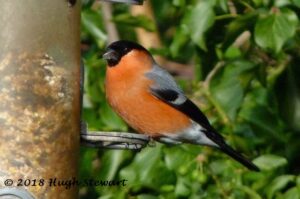
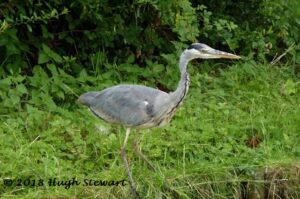
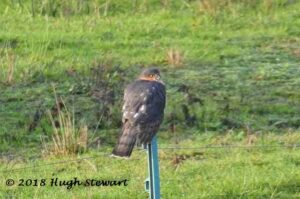
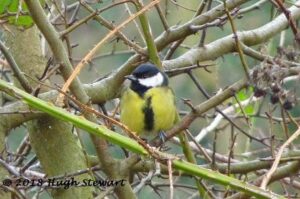
Marsh Harrier Breeding Success
We’ve got another first breeding record for the Dee Estuary – Marsh Harriers! A pair bred successfully at Neston Reedbed and fledged 3 chicks. A juvenile bird with a very gingery cap (adult females have a cream coloured cap) which is being seen regularly at Burton Mere Wetlands RSPB is most probably one of the brood.
Our own Bill Wonderley played a small part in this story as a volunteer warden for the RSPB, keeping an eye on the reedbed one evening a week, and helping to ensure breeding and roosting birds were left undisturbed. Little did he know the outcome would be this rewarding!
Sadly the Cattle Egrets did not repeat last year’s breeding at BMW, but there is still a bird present in the area, so fingers crossed for more good news next year. There are also several Great White Egrets on the Dee still, so surely it is only a question of time before this species breeds too!
Hen Harrier Day
This Sunday 14th August there will be a Hen Harrier Day event at Parkgate. The gathering is not aimed at spotting Hen Harriers on the Dee salt-marsh – most birds will remain on their moorland breeding grounds for a few more weeks yet. But rather this is one of several similar events being held around the UK spreading the word on the sad plight of Hen Harriers, other raptors and even mountain hares that are being persecuted on upland grouse moors. This will mark the fifth year for Hen Harrier Day, with the number of events and attendees growing each year. The weekend dates are chosen to coincide with the start of the grouse shooting season on the “Inglorious Twelth”.
Speakers will include well known naturalist and TV personality Iolo Williams, and leading conservation campaigner Mark Avery (ex. RSPB Conservation Director). The day starts at 12 noon at the Old Baths and is scheduled to finish at 3pm. If you plan to go, parking may be at a premium so I recommend turning up early and going for a stroll first. You could even spoil yourself with an ice-cream!
Hope to see you there in support of a great cause.
If you were at the AGM in May, you know that I did not show my photos due to a technical glitch! So I am attaching some of them here now – mainly because I do not have any photos of Marsh or Hen Harriers! So you will have to put up with Little Grebe, Song Thrush, Merlin and a juvenile Mute Swan.
I hope you enjoy the rest of the long, hot summer! See you in September for the new and exciting Club programme.
Hugh Stewart
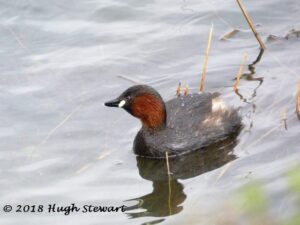
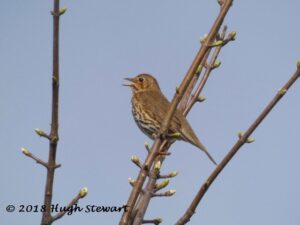
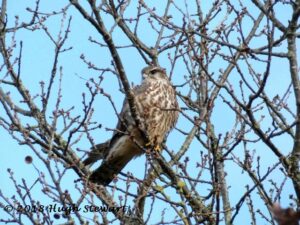
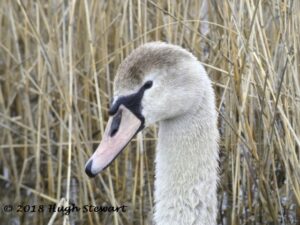

Those of you present at the last Indoor meeting will know that I didn’t have any announcements to make! As many of you are possibly aware, birding can sometimes become a little quiet at this time of year, as we move between the breeding season and the peak autumn migration period. The ongoing high temperatures we are enduring do not help either, as many birds seek shade to avoid the worst of the heat. Already adult birds are starting to moult their feathers and become (even more) skulking as they hide from potential predators!
There are still young birds to be seen though, such as this cute juvenile Pied Flycatcher we saw at Elan Valley; and a young Great-spotted Woodpecker (with the red cap) that was being fed by mum at a peanut feeder at Burton Mere Wetlands. The young bird soon learned to feed itself! Goldfinches have been coming to my own garden for a few days now.
Small numbers of waders are starting to return to the Dee from their summering quarters, either to stay for the winter or as a staging post before carrying on further into southern Europe and Africa. These early birds are often failed breeders but may still show some or all of their breeding plumage, like the Turnstone with some remnant chestnut feathers I saw on Hilbre. You can of course be in the right place at the right time. A Green Sandpiper dropped into BMW Reception Pool and gave great views. A Song Thrush sang heartily from the conifers where we parked at Cynwyd on Tuesday. This species seems to me to be very elusive while breeding but starts singing again for a while when the young have fledged, as if to celebrate raising another brood successfully!
While it can be difficult to find birds just now, there is a still lot of other wildlife to seek out. Orchids including a single Pyramidal Orchid have been showing at BMW. Butterflies are around in good numbers too together with dragonflies and damselflies.
A couple of events for your diaries:
Firstly, the annual Exhibition of Wildlife Art is on again at Gordales from 27th to 29th July. Free admission, and open Friday and Saturday from 9.30am until 6pm; Sunday 10.30am until 5pm. Well worth popping in if you are passing by.
There will be a Hen Harrier Day event at the Old Baths, Parkgate on Sunday 12th August from 12 noon until 2pm. Speakers will include Iolo Williams and Jeff Clarke. This event is to publicise the ongoing plight of Hen Harriers specifically and other wildlife in general that are suffering badly from illegal persecution. It should be entertaining and informative.
Finally, you may have heard that Mersey Ferries and the RSPB are hosting a ‘Liverbird’ Bird Watching & Nature Discovery Cruise on the River Mersey and out into Liverpool Bay, on Sunday 19th August. Sadly this cruise is sold out already! If we hear of additional dates, we will let you know a.s.a.p.
Hugh Stewart
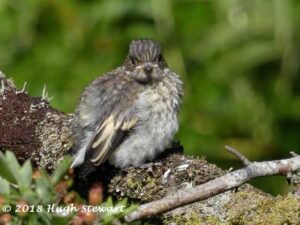
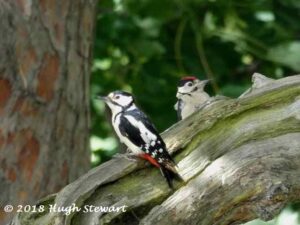
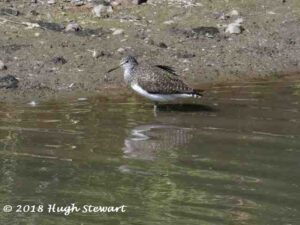
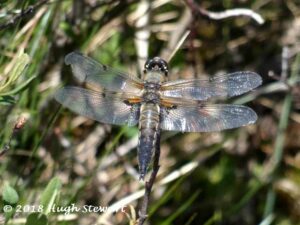
So finally we had some warm and sunny weather over the bank holiday weekend! Even if it did not last for long, it put a smile on everyone’s face for a few days at least. This winter seems to have been never-ending, and the cold and wet weather has certainly had an effect on our local birds. Migrants that come to the Wirral to breed over the summer have been really slow returning from their wintering grounds in southern Europe or Africa.
While I have seen House Martins and Swallows now, I have still to spot a Swift – although some have been reported locally. All these species rely on insects for food, so bad weather severely limits their ability to find prey items. All is not lost however, provided we have a settled period soon. Many other species, primarily the resident birds, are well into the breeding season though. Blackbirds and Robins have been active in my garden, and Goldfinches have been feasting on sunflower hearts in good numbers. At Burton Mere Wetlands RSPB reserve, young Lapwings, Canada Geese and a single Tawny Owl have all been spotted.
Wirral was graced with a rarity recently, with an Iberian Chiffchaff present at Thurstaston for a few days. As the name indicates, this species breeds in Spain and Portugal, but clearly over-shot its normal range. It is very difficult to tell the difference visually from the more familiar Chiffchaff, but luckily it has a distinctive call. You will have to come to the AGM to hear it!
Unfortunately the canal trip planned for Thursday this week had to be cancelled at the last minute because of a problem with the boat. Obviously disappointing news but there is always next year!
I am looking forward to next week’s field meeting to Moelydd – a new location for me. By then all the summer migrants will surely have returned and we will see some good birds! Hope to see you there.
Hugh Stewart
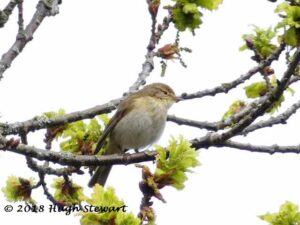
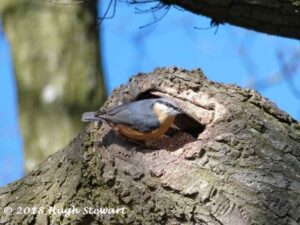
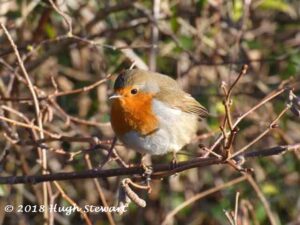
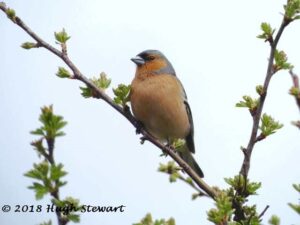
I had heard that a flock of 5 Scaup had taken up temporary residence on West Kirby Marine Lake, so on Monday morning I popped along to see if they were still there. Now these are birds that are normally seen off the coast on Wirral in the winter, about a mile away, bobbing up and down in the waves and so difficult to see well. They breed in Iceland, Scandinavia and into northern Russia. Occasionally, especially after stormy weather, one or two birds may take refuge on a lake or reservoir. Some of you may remember we saw a male bird on a field meeting to Colemere in January 2017, but while the views were good they were still a little distant.
On the Marine Lake however, and in stark contrast to the Jack Snipe at Burton Mere Wetlands on Sunday, the Scaup were right by the railings at the North end busily diving to feed. There were 3 males and 2 females. The close views allowed a great opportunity to study the beautiful plumages of both sexes, and the diagnostic elongated head shape with no hind crest that helps distinguish them from the closely related Tufted Duck.
There were also a pair of Red-breasted Mergansers further out towards the middle of the lake, and the usual mix of waders roosting on the rocks as the tide came in. These were mostly Redshank, with smaller numbers of Turnstone and Dunlin, and a single Knot.
By now, my fingers were getting cold so I returned to the car! I do not know how long these birds will stay before returning to the sea, but I recommend having a look for them if you can.
The cold weather has also brought in more Redwing and Fieldfare, and many of you have told me that you have had them in your gardens, along with wintering Blackcap. Sadly, the extreme low temperatures and snow will undoubtedly cause fatalities to many birds, despite our efforts to feed them and provide fresh water. Small birds are especially susceptible to the cold because they have a greater surface area to volume ratio and so lose heat more quickly. Some species combat this by huddling together on branches or in holes. 63 Wrens were once found roosting together in one box! Provided this winter is an exception rather than the new norm, the populations should hopefully recover over the next year or two.
As I write, the weather is getting a little milder so Spring is maybe not so far away, and birds can start their breeding season in earnest.
Hugh Stewart
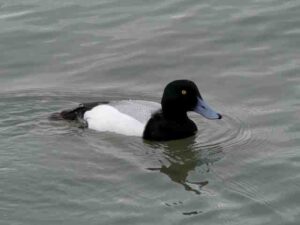
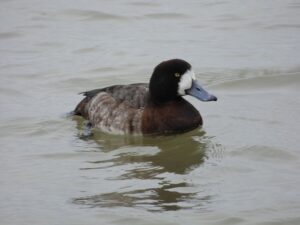
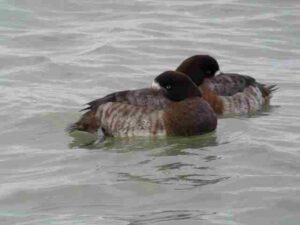
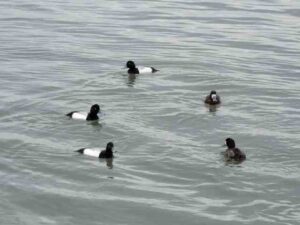
I have to confess that I have not done a lot of birding since the start of the year! I seem to be turning into a bit of a fair-weather wuss, which meant I missed a famed Wirral birding event. The beginning of January saw some strong winds coinciding with high tides and the water came right in to the wall at Parkgate and elsewhere on the river.
The result, so I heard, was a birding extravaganza, with great views of harriers, short-eared owls and other raptors. Water Rails were flushed off the marsh and small rodents such as voles and mice swam for their lives! An occasion like this is arguably one of the most sensational natural world sights in the UK. Did any members make it to Parkgate or elsewhere for the high tide? If so, let us know how you faired.
With the weather remaining inclement, it should have increased the numbers of birds and different species seen on the Big Garden Birdwatch. I hope many of you joined in and enjoyed the annual bird watch from the comfort of your armchair. Now that is my idea of birding!
Canal Trip
I am planning another day trip with the Wirral Community Narrowboat Trust on Thursday 10th May. The boat will take us from the Cheshire Cat at Christleton, at around 9.15am, along the Shropshire Union Canal to Wharton’s Lock and Beeston, where we stop for lunch, before returning to Christleton about 4:30pm.
The boat has a toilet, and free tea/coffee is provided, so you only need to bring your lunch and binoculars! The cost will be around £13 – £14. Priority will be given to members who have not been on a trip before or not for some time; then it is first come – first served!
Please email me to book or for more details. [email protected]
Hugh Stewart
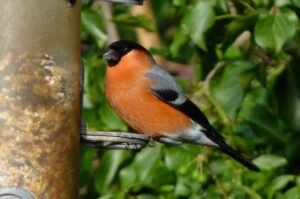
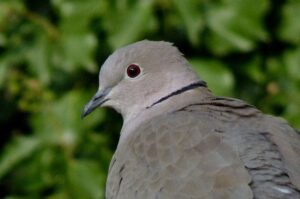

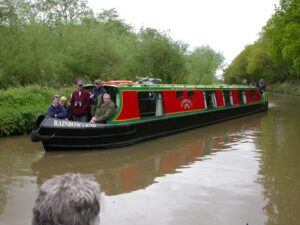
The snow and sleet that many of us experienced over the last week or two was confirmation, if it were needed, that winter has truly arrived. With the harsher conditions, birds are visiting the feeders in larger numbers, and they may become reliant on these food supplies. It is great to feed the birds in your garden, but be careful about suddenly stopping as this may put them at risk of starvation, if alternatives are not readily available.
Blackcaps, almost certainly from the continent, have been reported in gardens already, with our own breeding birds departing for southern Europe. Short-eared Owls and both Hen and Marsh Harriers are still being spotted regularly from locations such as the Harp Inn, Parkgate or Denhall Lane. Blackbirds and other thrushes hunt out berries and fallen apples.
A reminder that the 2018 Big Garden Birdwatch is coming soon, from 27-29 January (or as near as possible to these dates). Here are a few tips to help you:
1. Be prepared – fill your feeders and refresh the drinking water.
2. Start early – the early bird really does catch the worm!
3. Get comfy with pen and paper, drink, snack at hand.
4. Use the RSPB website to report your findings; or use the form in Nature’s Home.
5. Share the experience, and get your friends interested.
This will be final Hugh’s News of the year so, on behalf of the Committee, I would like to wish you all a Merry Christmas and a Happy New Year.
I thought I had to end with a seasonal Robin photo – sorry it was not in the snow!!
Hugh Stewart
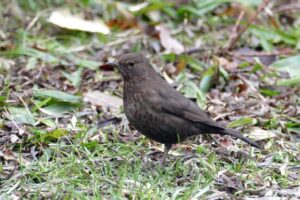
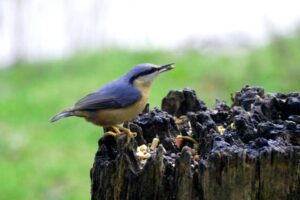
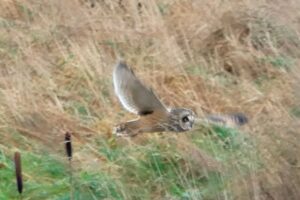
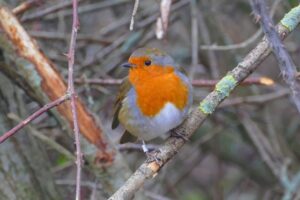
On a recent short holiday in North Norfolk, it occurred to me how the distributions of several familiar birds have changed over just the last couple of decades. Species that one had to travel away from Wirral to see, to more southerly or easterly counties, are now regularly seen on the Dee Marshes.
When I moved to Wirral 27 years ago, a Little Egret was still a national rarity, certainly away from the south coast, and I remember visiting Parkgate to “twitch” one. Now they are so familiar we almost take them for granted! They have been joined in the last few years by both Cattle and Great White Egrets, the former breeding for the first time this summer. Avocets and Cetti’s Warblers are now regular breeders.
There has been a regular Hen Harrier roost at Parkgate for some time, but we are now also graced by Marsh Harriers year-round.
Sadly there are some negative trends too. I saw several Grey Partridge around Holkham Gap, a species that is increasingly rare on Wirral.
But there are still more potential settlers. Red Kites have colonised Norfolk, and Bearded Tit and Bittern are regular species there. All three of these species have been seen periodically on Wirral, so how long before these birds are resident?
Hugh Stewart
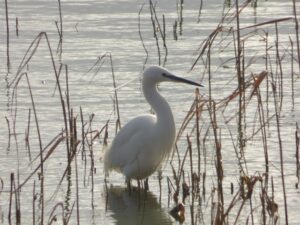
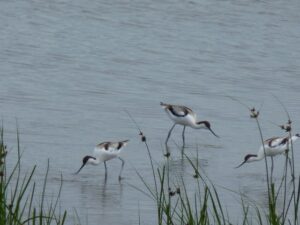
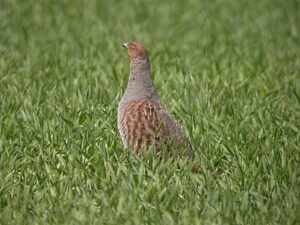
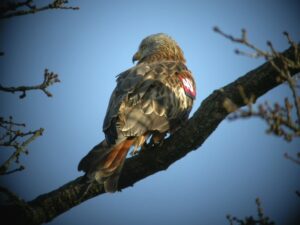
“It’s an ill wind” as the saying goes. Well the strong winds and heavy rain last week brought some good birds to our shores – if you were prepared to brave the blowy conditions! There were many sightings of Leach’s Petrel and Grey Phalarope from various points along the North Wirral coast from New Brighton to Hoylake and Hilbre.
There was a supporting cast of the occasional Sabines Gull, Manx Shearwater, Black Tern and Little Gull. There was also a Red-necked Phalarope at Frodsham! I did not manage any photos of these rarer species, but numbers of our more familiar waders are building up now for the winter and I did see a group of Turnstones bathing on the rocks at West Kirby Marine Lake. The first ring-tail Hen Harrier and Short-eared Owls have been seen on the salt marsh. Hopefully there will be enough voles to keep these magnificent birds here over the winter.
As we pass into autumn, most birds have finished breeding now although you may find the odd juveniles from the late brood like this Moorhen preening itself in the sunshine at Burton Mere Wetlands. On calmer days, family groups of Buzzards can often be seen circling in the thermals, “meewing” to each other. Of note, I saw a young Wood Pigeon in my garden with what appears to be a mite or growth on its face. Can anyone identify it? No prizes, but I would be interested in any suggestions.
Wirral Community Narrowboat Trust is very proud and honoured to have been awarded the Queen’s Award For Voluntary Service in June 2017. This Award is considered to be the MBE of volunteering. The Award was announced on 2nd June 2017, and two representatives of the Trust were invited to a Garden Party at Buckingham Palace in recognition of the achievement. Our Club has been a regular supporter of the Trust through our Canal Trips, and I have passed on our congratulations to the Trust. I am already thinking about planning another trip next May!
Hugh Stewart
I hope you are enjoying the summer! The weather has been typically variable but I think not too bad overall. I always say to myself “It could have been worse”!
On the birding scene, July is often thought of as a quiet month. The breeding season has largely finished so bird song and displays diminish, and many birds undergo a moult that can make then more indistinct and elusive. So now is a good time to look at other areas of the natural world such as butterflies and dragonflies.
I am including a few photos from a recent guided walk I attended at Whixall Moss. The weather was not ideal, being a bit cool and windy, but we still saw some nice subjects: Comma butterfly, a Heart and Dart moth and lots of 5 Spot Burnets.
At BMW, the single Cattle Egret chick is still around the nest testing its wings and should fledge any day now. A pair of Mediterranean Gulls has 2 fledged young. For both species, it is the first breeding record for the reserve.
OK, I have talked about the summer. So I don’t want to be too pessimistic but the first signs of autumn migration are already present – and the longest day was only a couple of weeks ago! But there have been sightings of waders such as Common Sandpiper, Spotted Redshank and Ruff at Burton Mere Wetlands this last week, the first birds returning south from their breeding grounds.
These initial migrants are usually failed or non-breeders, with the peak period still to come. They are often still in (partial) breeding plumage though, so can look bright and quite different to their winter garb that we are more familiar with. This may cause some confusion initially, but it demonstrates for example why the full name for the familiar winter species here on Wirral is Red Knot.
Hugh Stewart




After the mild winter, spring migration seemed to start early. However, the lack of a settled spell of weather has meant that birds have only been coming through in dribs and drabs.
Wheatears have been fairly numerous, but birds such as Ring Ouzel, Yellow Wagtail, Redstart and Whinchat have been harder to find. I did find single Willow Warbler and Whitethroat, and heard a lone Reed Warbler at Leasowe on Friday.
Several White Wagtails were in a ploughed field beside Banks Road. There is still time for more passage birds however, given some favourable conditions. I also saw my first Swift of the year by Shotton Fields, one of my favourite birds of every summer.
At Burton Mere Wetlands meanwhile, the first Lapwing brood has already fledged (which is early), and the Avocets have started laying. The reed beds and woods are starting to fill with warblers, even though the wind can make hearing or seeing them difficult. The Little Egrets are active in Marsh Covert, and the Bluebells are also at their best now.
Finally, a reminder to start collecting your photos to show at the AGM on 25th May. If you do not want to present them yourself, I would be happy to do it on your behalf. Just load them on a memory stick and bring it along.
This has become a successful and integral part of the evening so please help contribute. See you there!
Hugh Stewart
I have just returned from a holiday in Costa Rica, and I know one or two members have also been there recently.
I am pretty sure they would agree with me that it is a beautiful country with magnificent scenery and wonderful wildlife.
What was particularly encouraging was how much the local people value their rich environment and the steps they take to maintain and preserve the national parks in particular.
I hope to give a talk on the country in the next programme but here are a few ‘tasters’.
Meantime, here on Wirral there are clear signs that spring has arrived. The first Avocets were at BMW in mid February.
This last week there have been reports of Wheatear, Sand Martin, House Martin and Ring Ouzel locally.
We will be looking out for more migrants during our next field meeting at Leasowe.
Hugh Stewart
It promised to be a nice Winter’s day so I travelled to Red Rocks in search of the Snow Bunting that had been reported over the previous day or two. I didn’t have to look for long as the bird was close to the slipway and feeding on the beach and amongst the rocks.
Photographers had scattered some seed for it, and it was very obliging for the few people gathered to watch it. It was probably so full it could not fly far even if it wanted to!
After admiring the beauty of the plumage and taking a few photos I moved on West Kirby Marine Lake. The air was still and the water was so calm, that there were beautiful reflections in the mirror-like surface. Although the air temperature was only around 5 degrees, with a bright sun and no wind-chill it felt more like a Spring day. A little flock of assorted waders was sitting on the rocks, basking in the warm sunlight.
Further out on the lake were several Red-breasted Mergansers, both male and female, and a couple of drake Goldeneye. They were all diving frequently to feed and they kept reappearing in a different place, making taking photographs difficult! Black-headed Gulls loafed on the pontoon as they often do here. I could not locate the female Goosander that had been reported here though.
Having completed a full circuit of the lake, I then moved on to Thurstaston Country Park and sat down in the visitors centre to scan the feeding station. It was not as busy as it might have been on a colder day, but several male House Sparrows looked smart in their breeding plumage.
Two Collared Doves were showing signs of displaying and paring off. A pair of stunning Bullfinches turned up, but were always very wary and quickly flew back into the trees. Even a drake Mallard on the pond look magnificent. If you saw this bird in an exotic Asian country you would drool over it, but I think we often take them too much for granted!
The following day the weather changed back to the normal grey, windy conditions, so it was nice to have been out on such a pleasant day. Spring is not quite here yet and there is still time for a sting in the tail, but it was a taste of things to come.
Last night I went to the evening with Iolo Williams at Neston Cricket Club in Parkgate. It was nice to see several Club members there too. Iolo regaled us with a brilliant talk on Raptors that was entertaining, informative, and hilarious in equal measures. I don’t think anyone went away disappointed. No pressure for my talk to the Club in June then!
Hugh Stewart